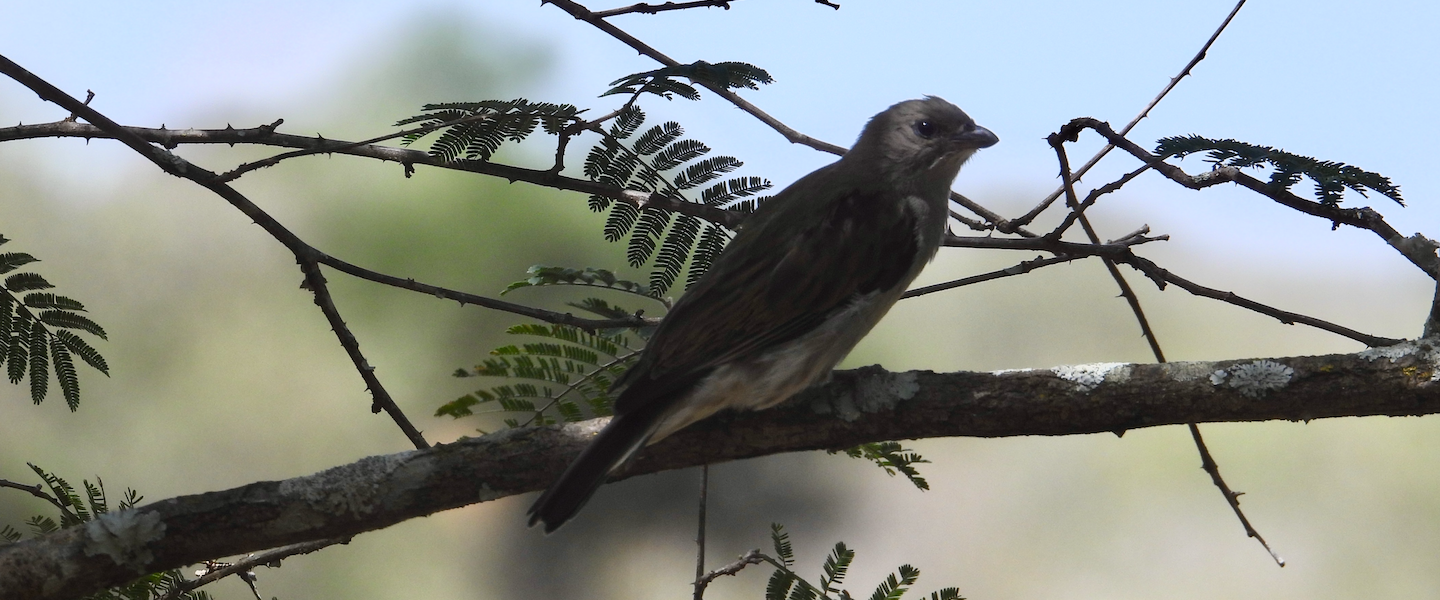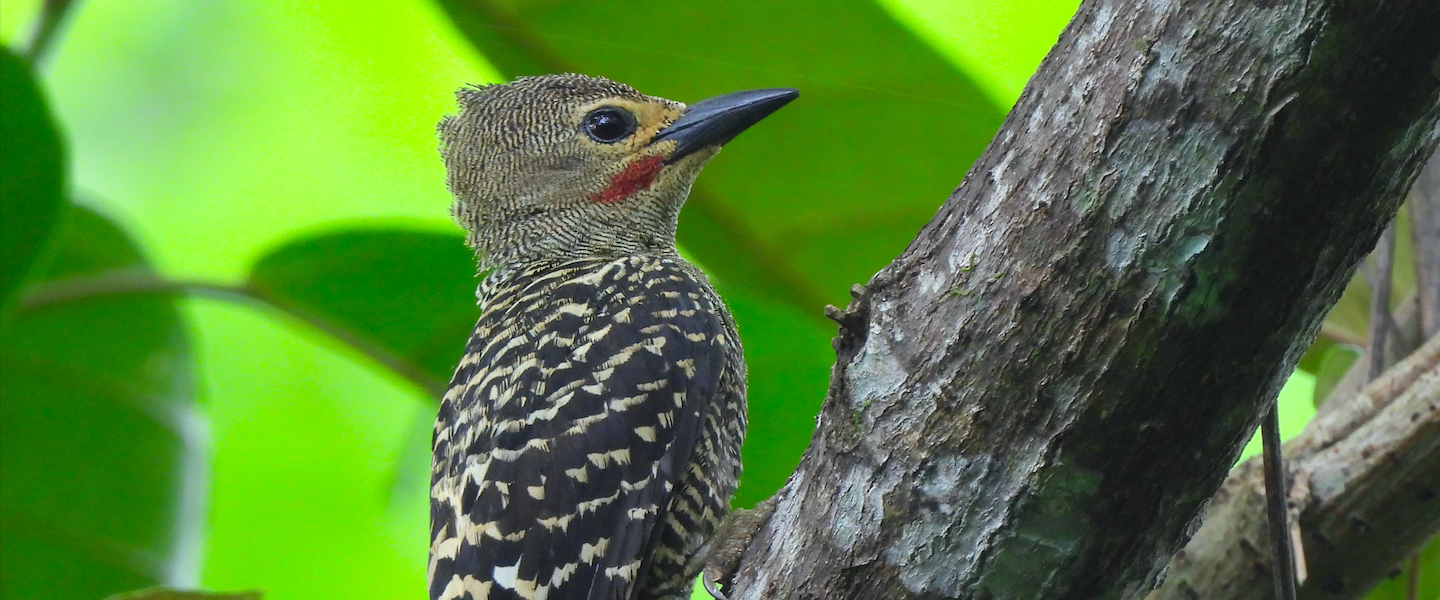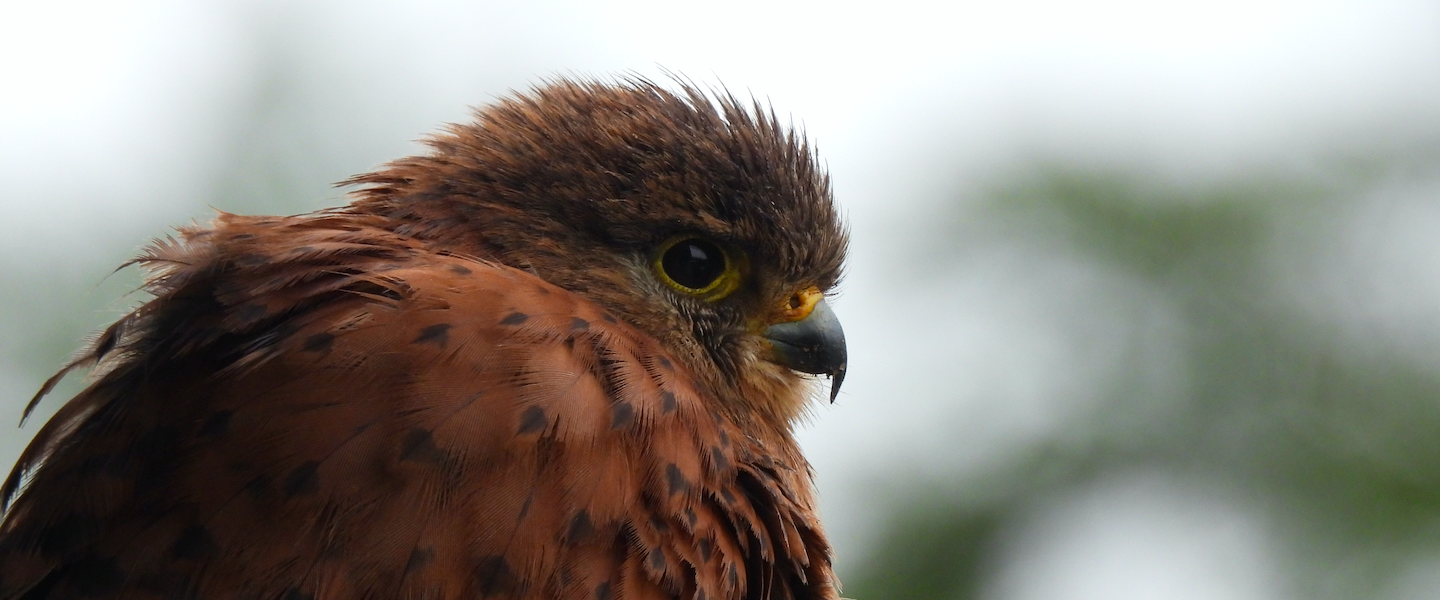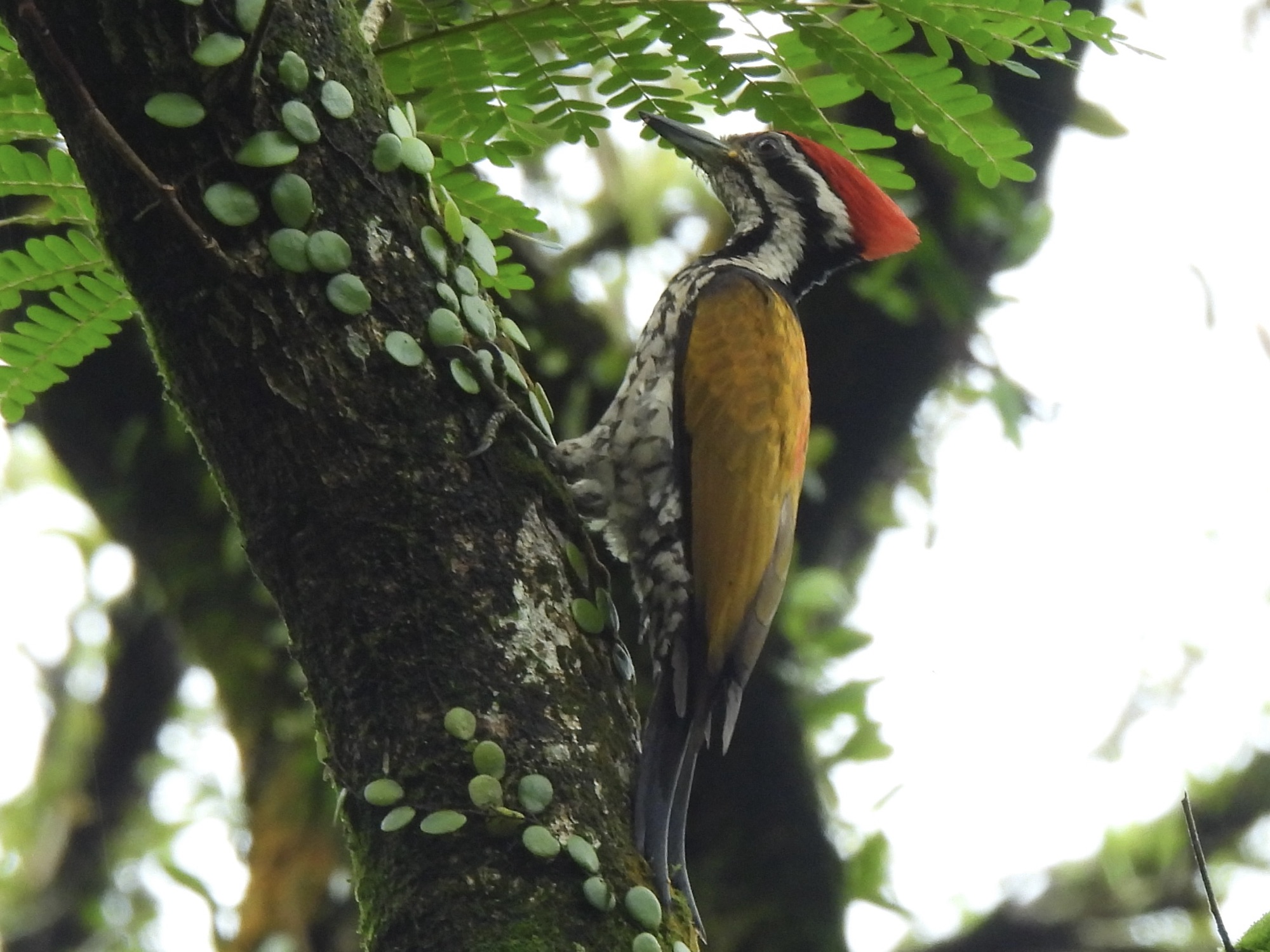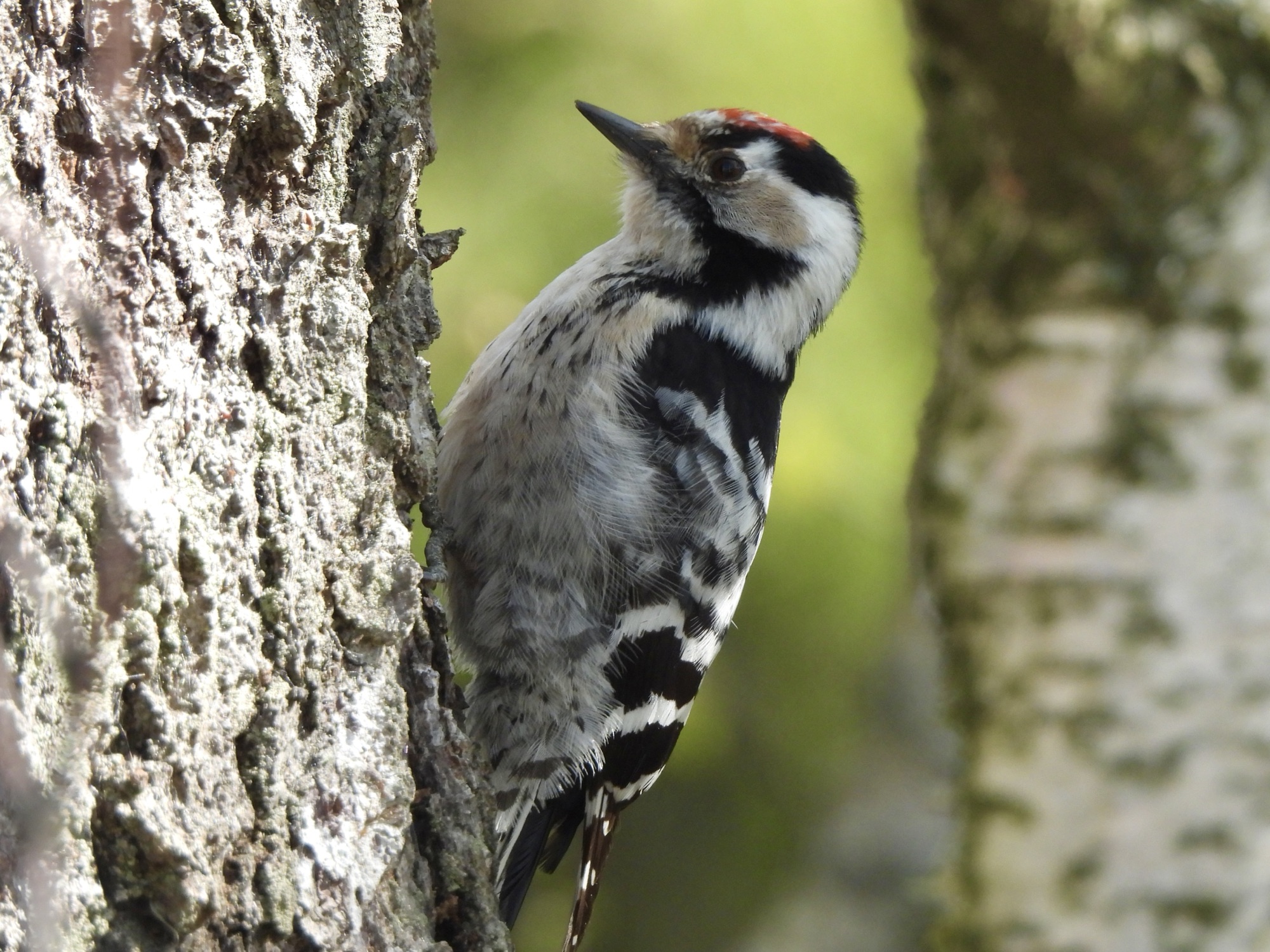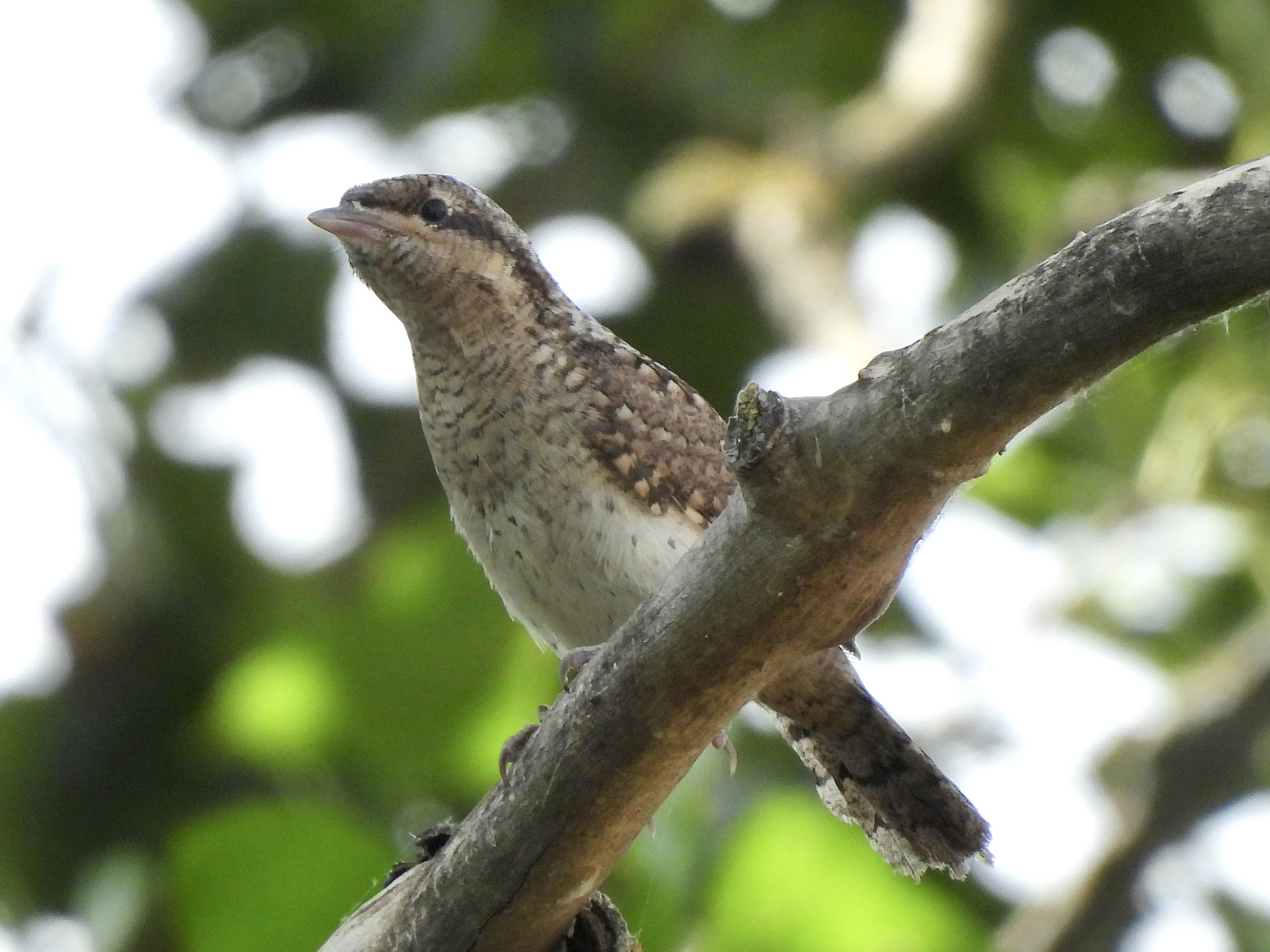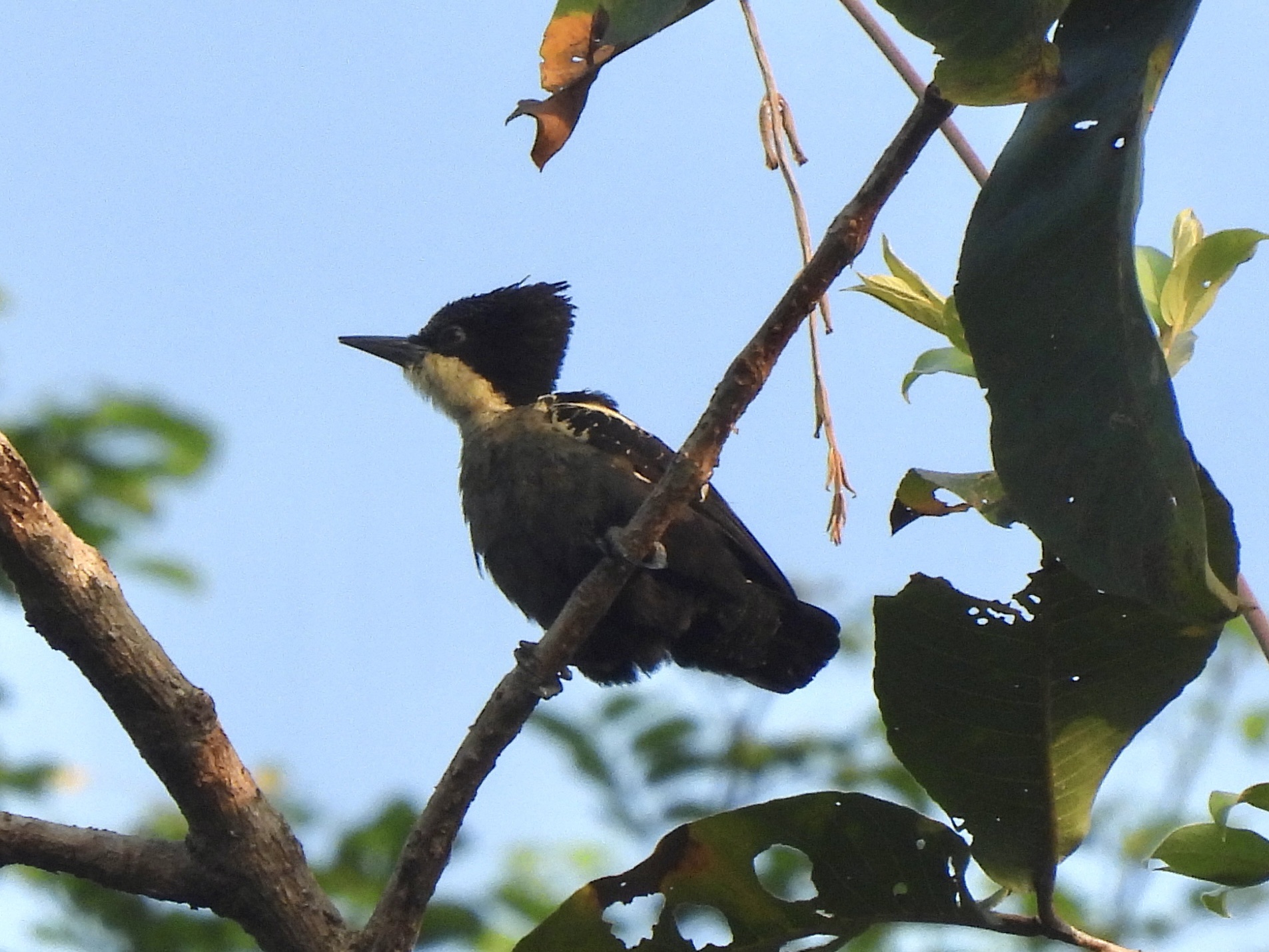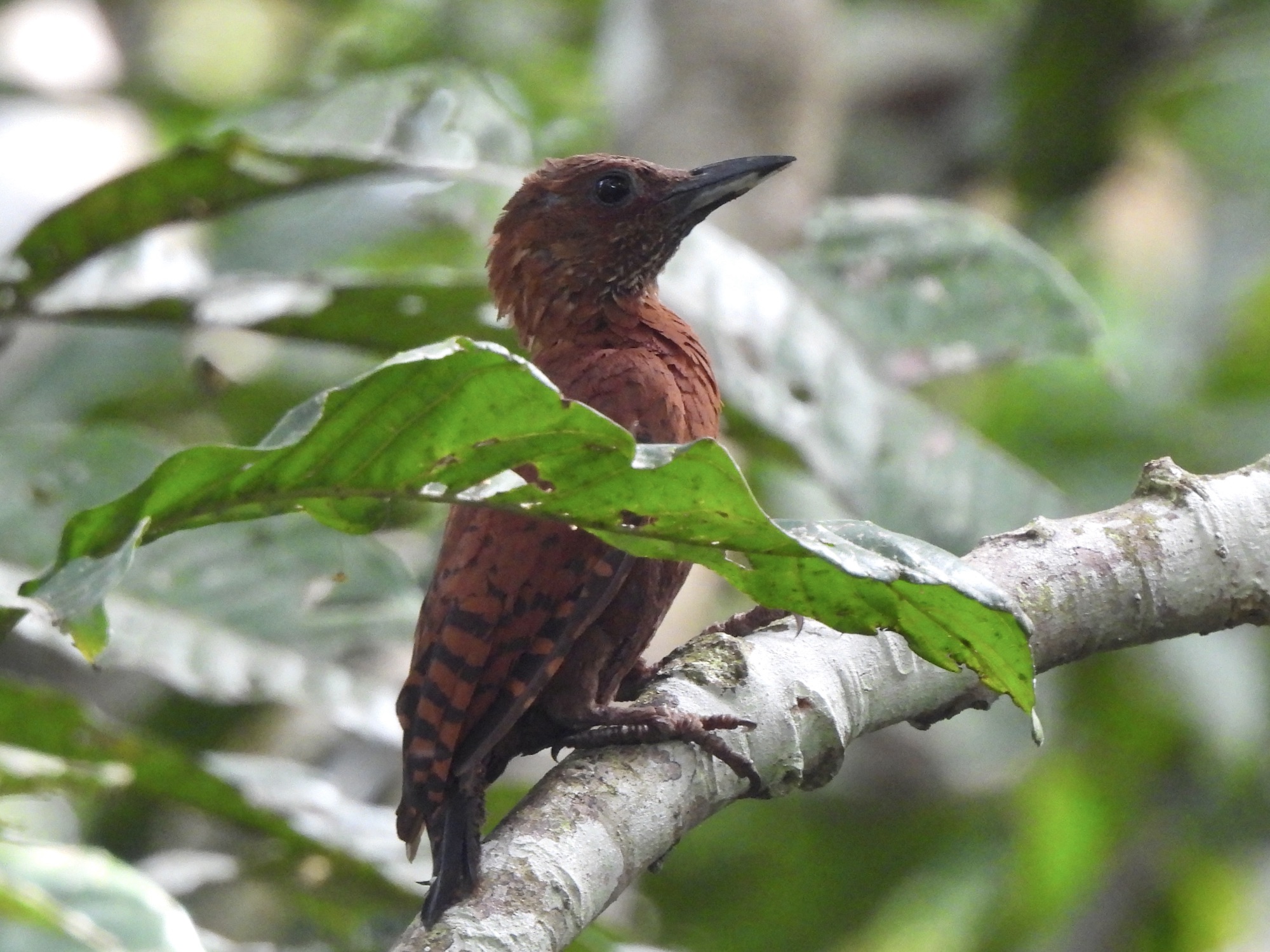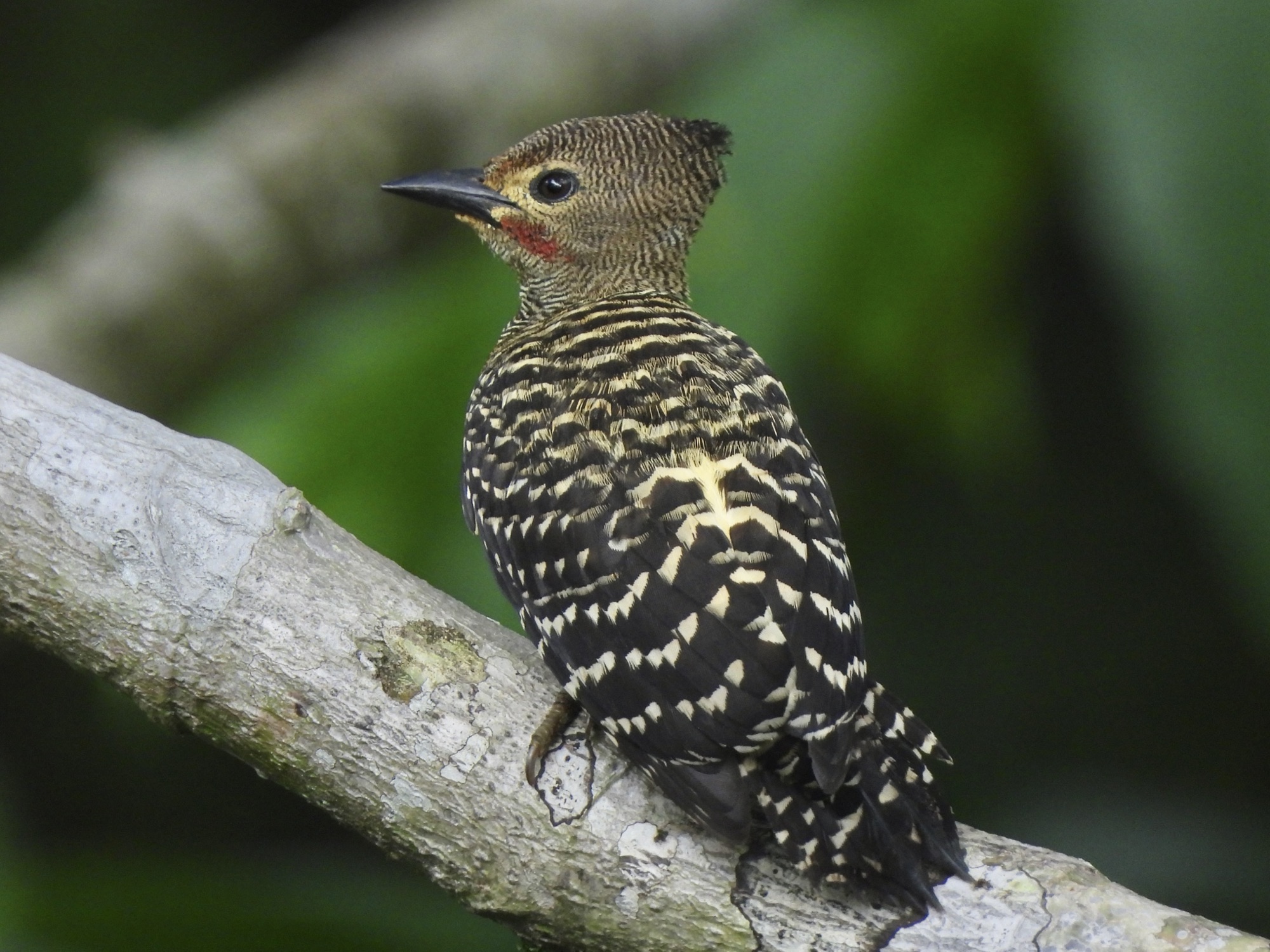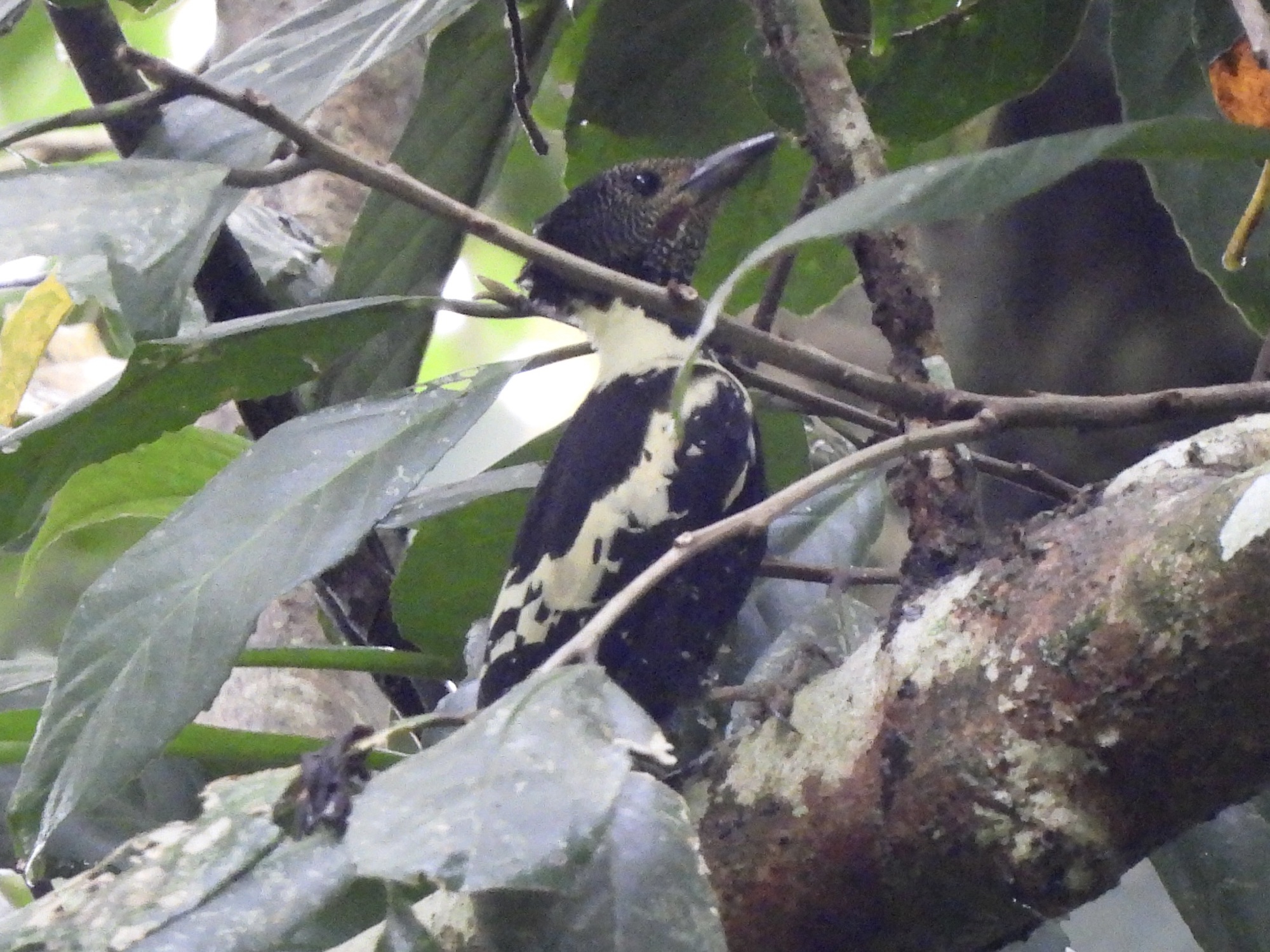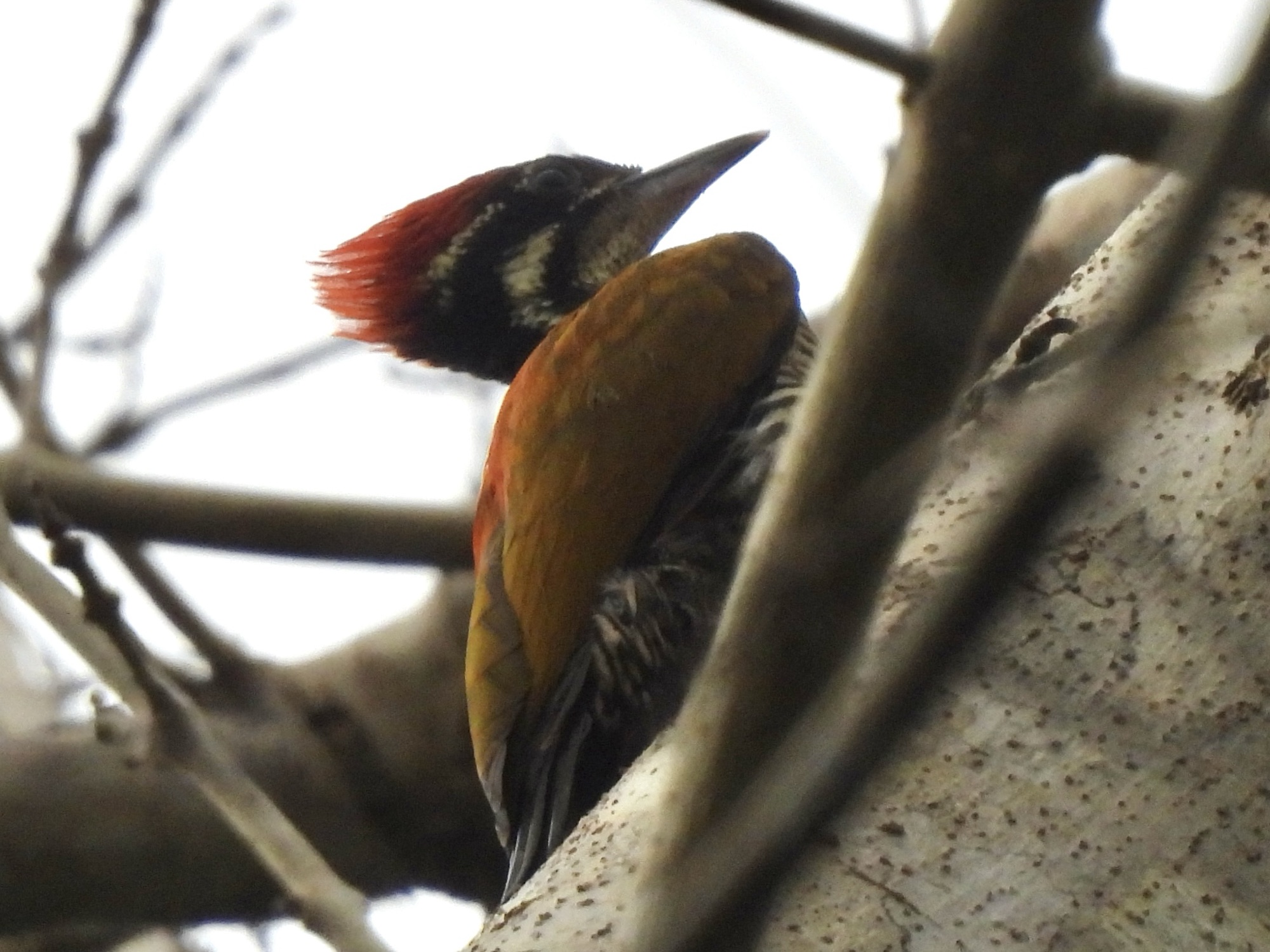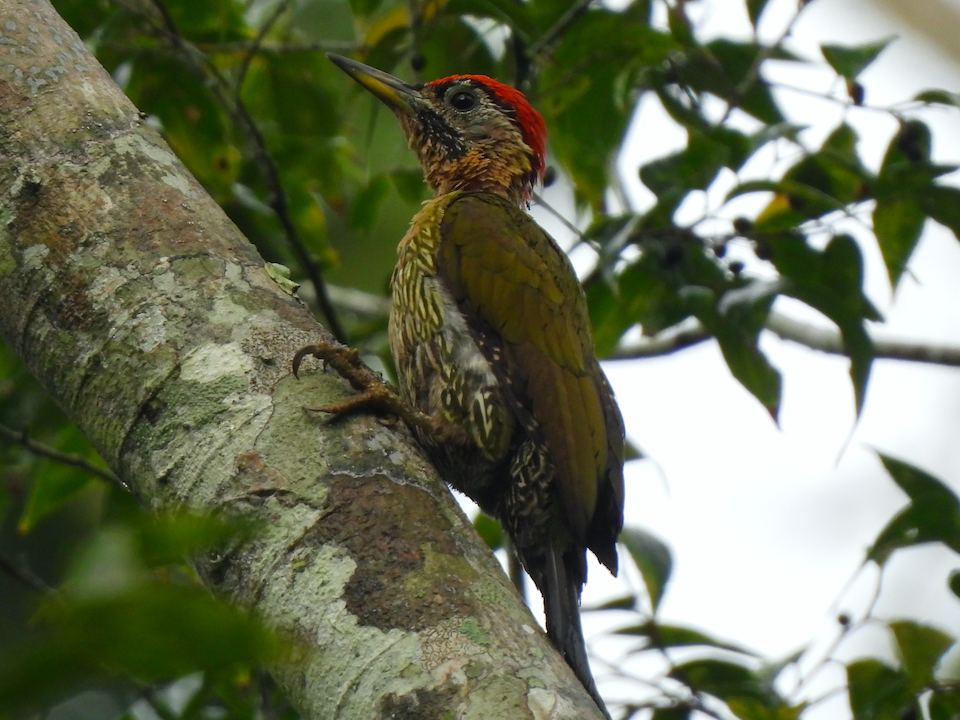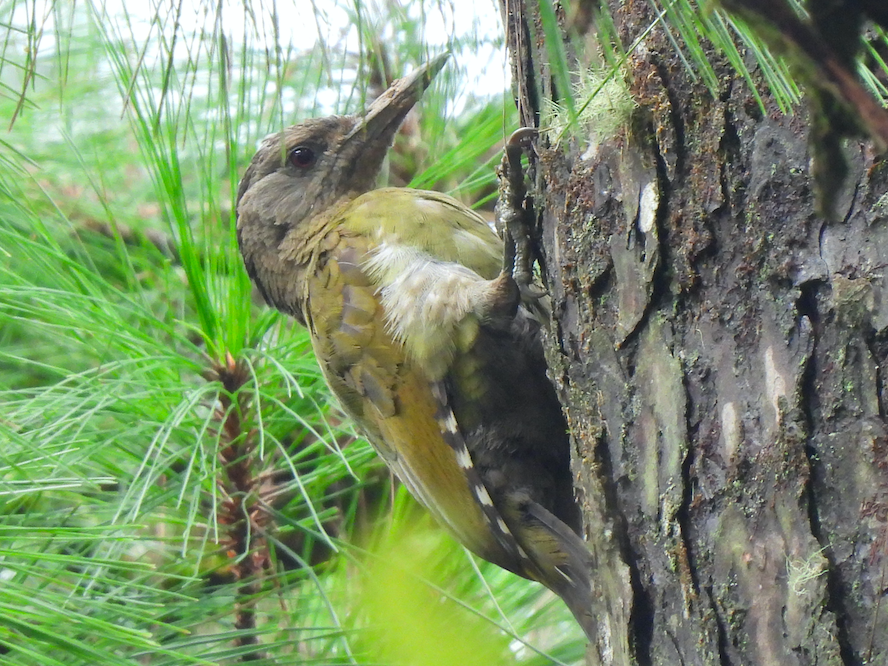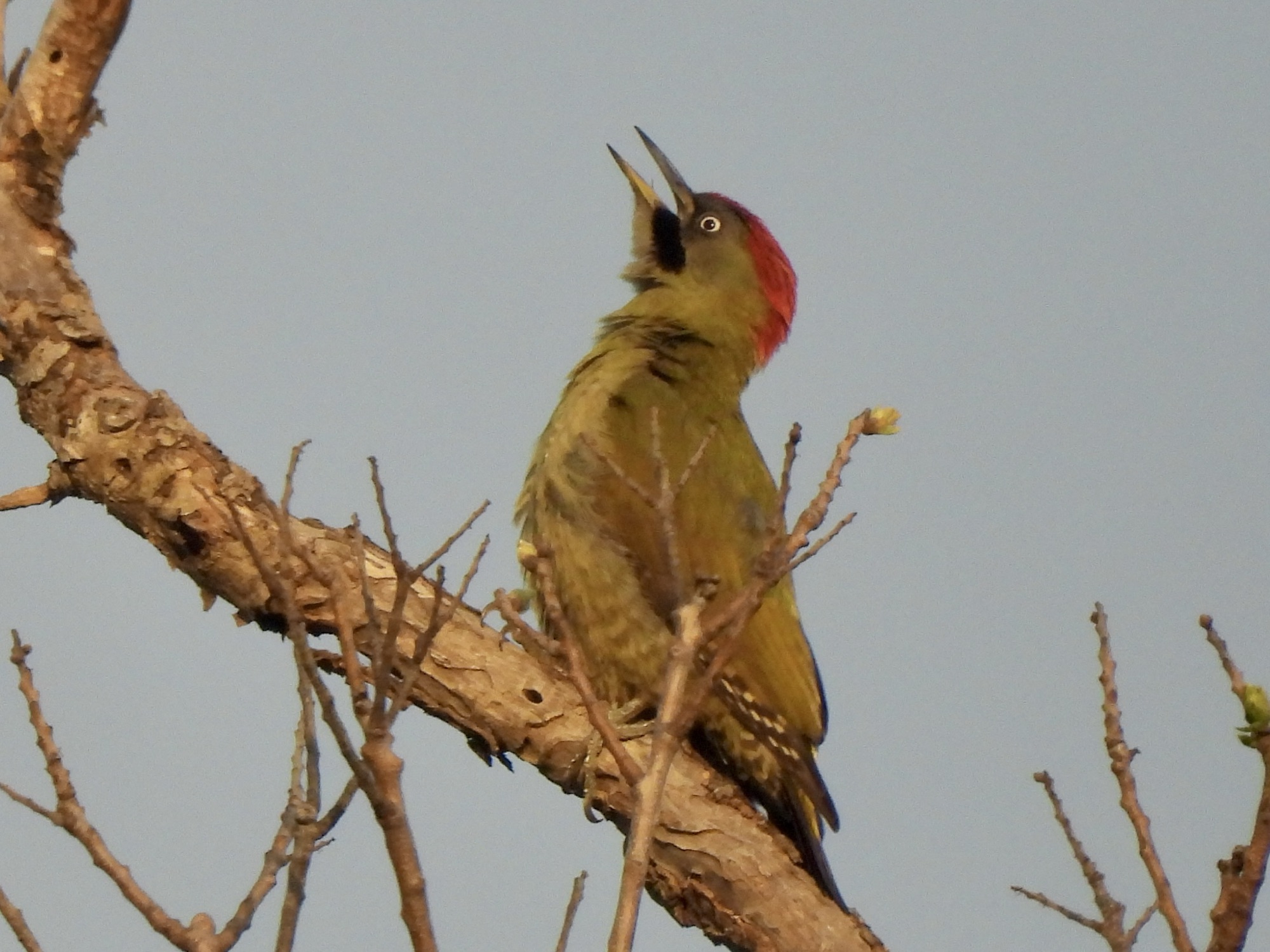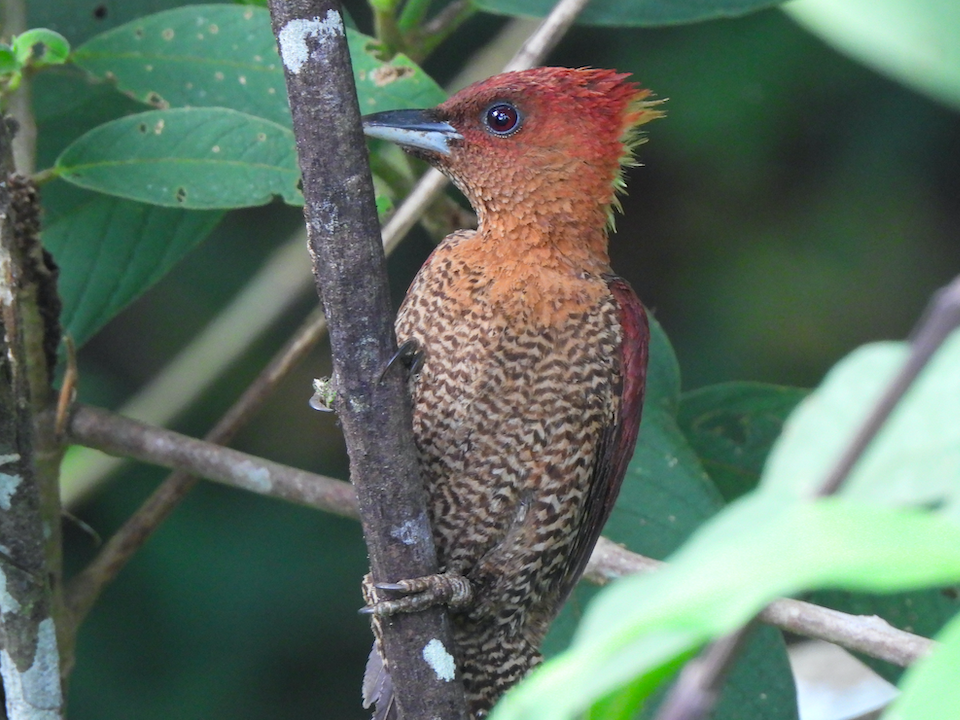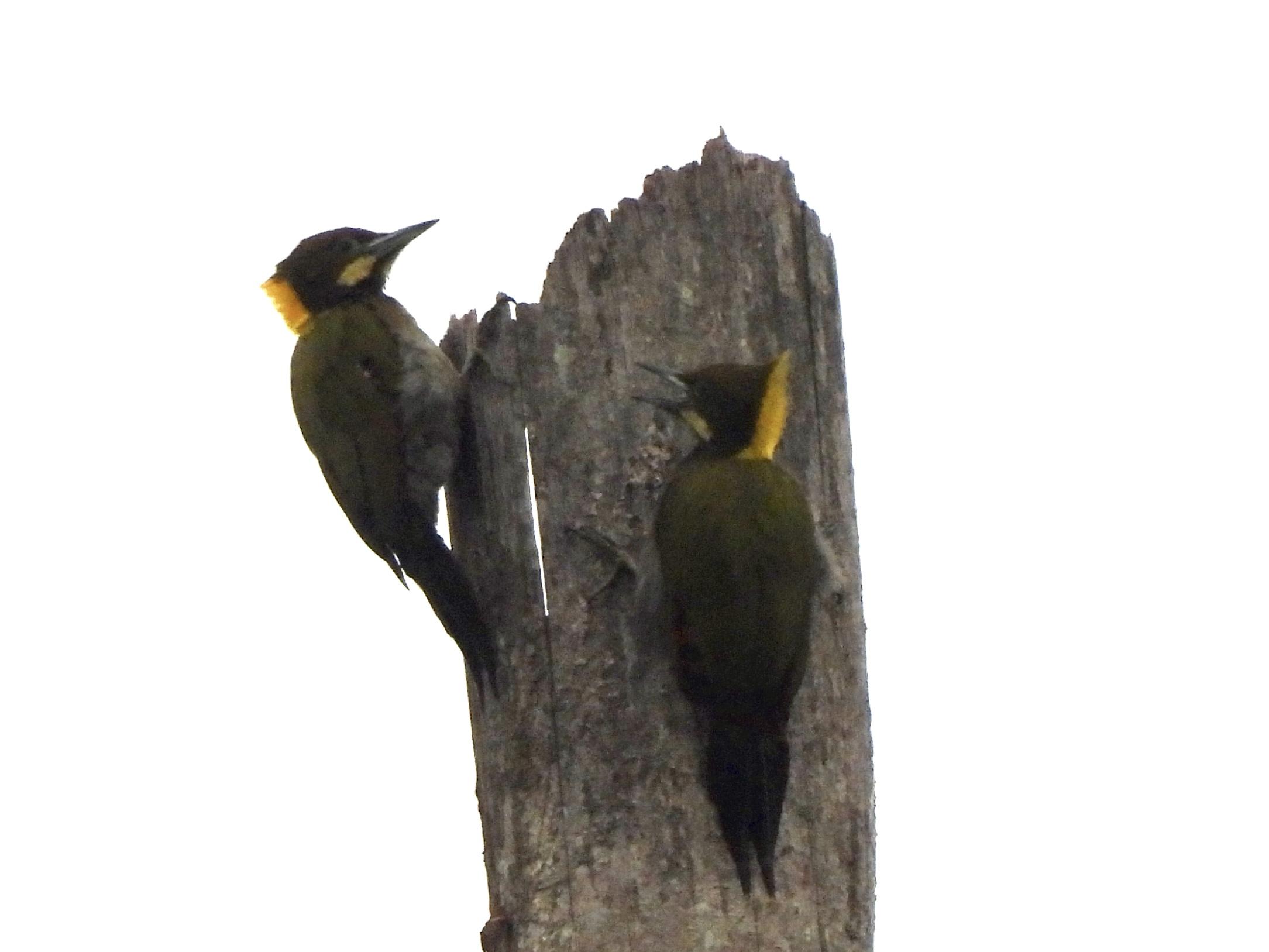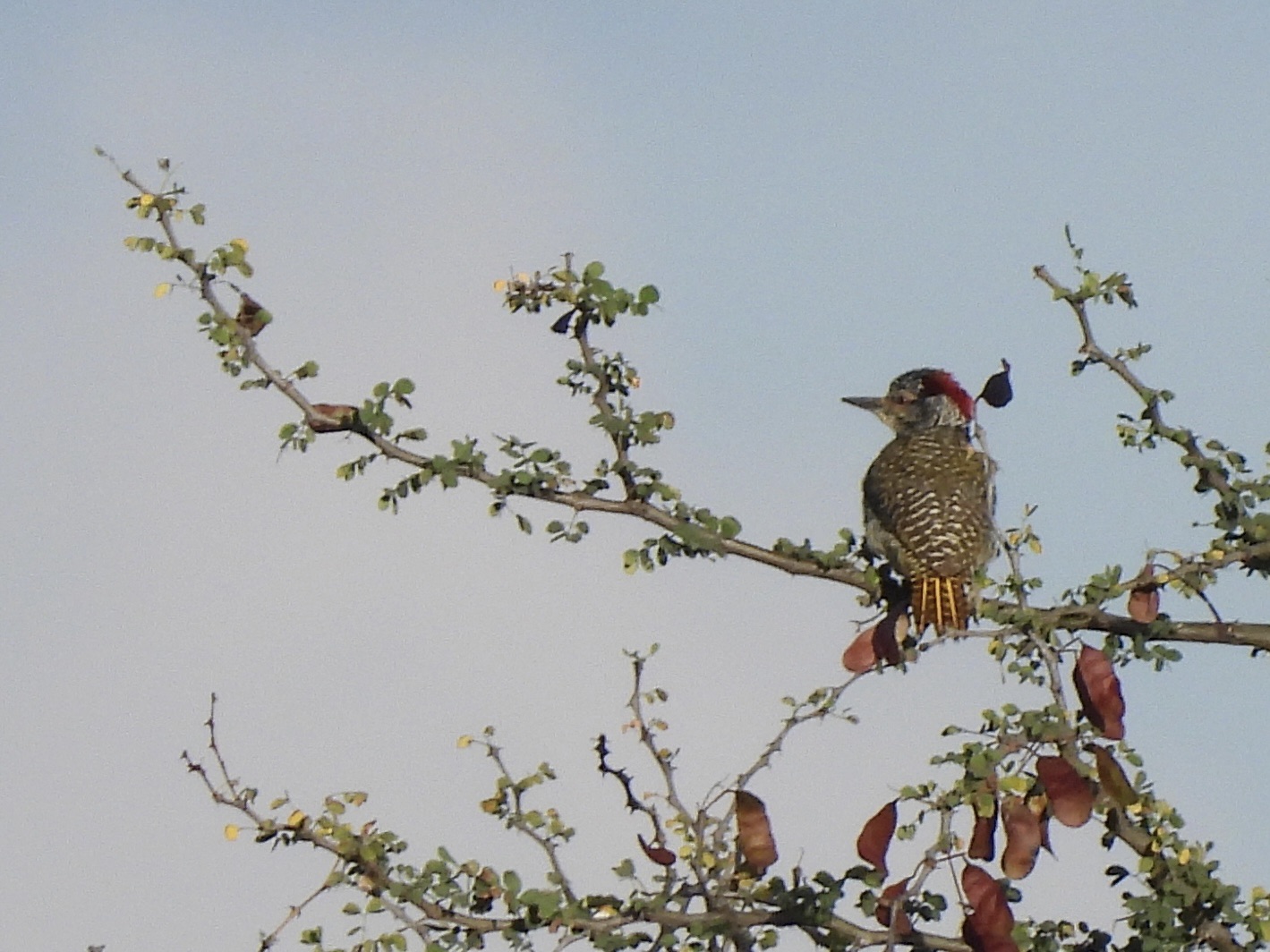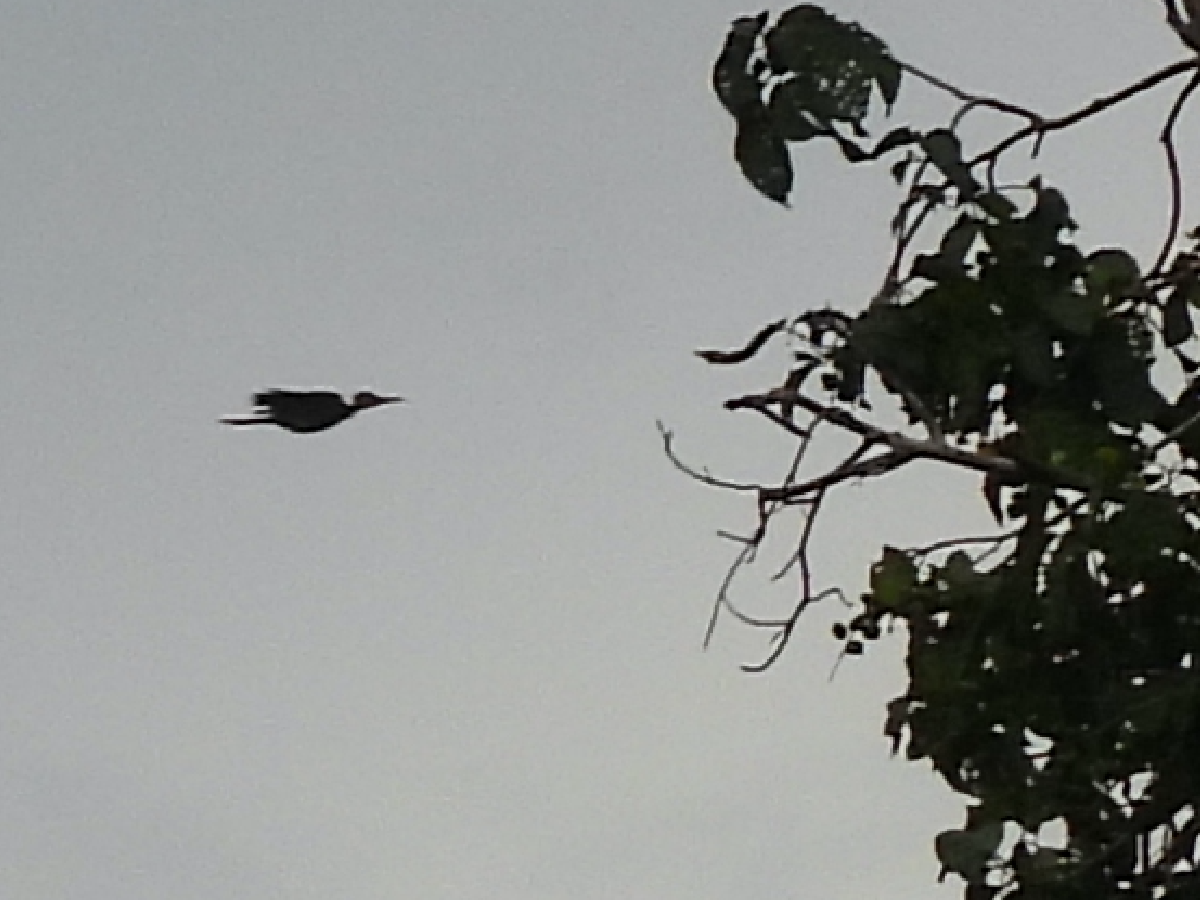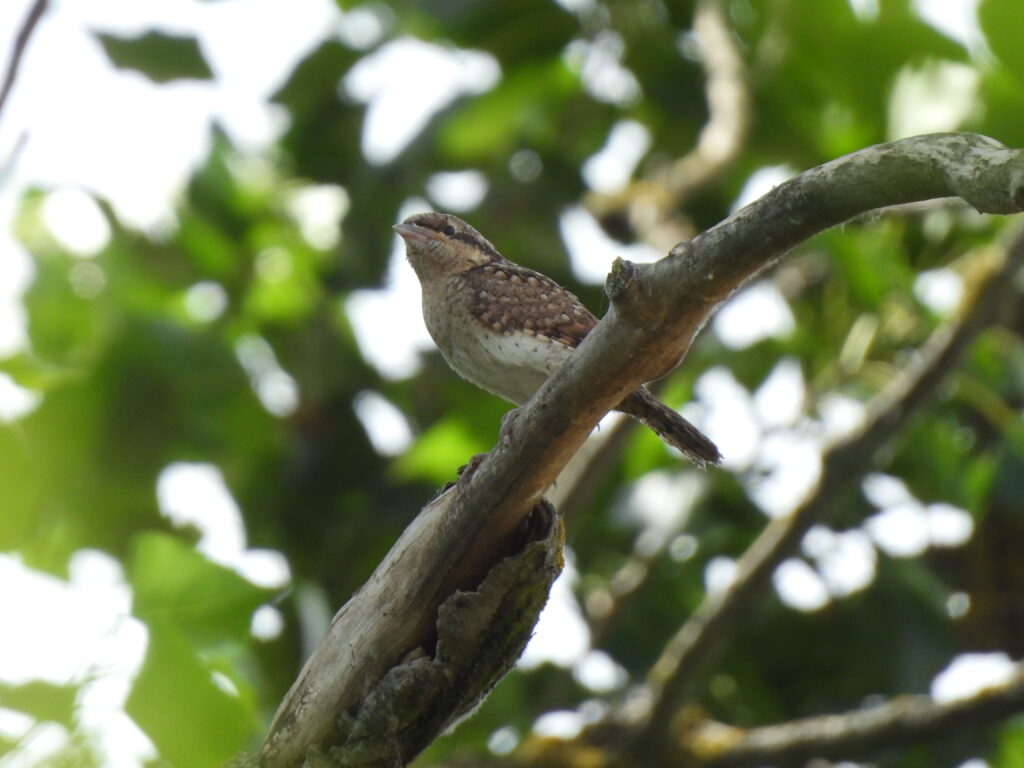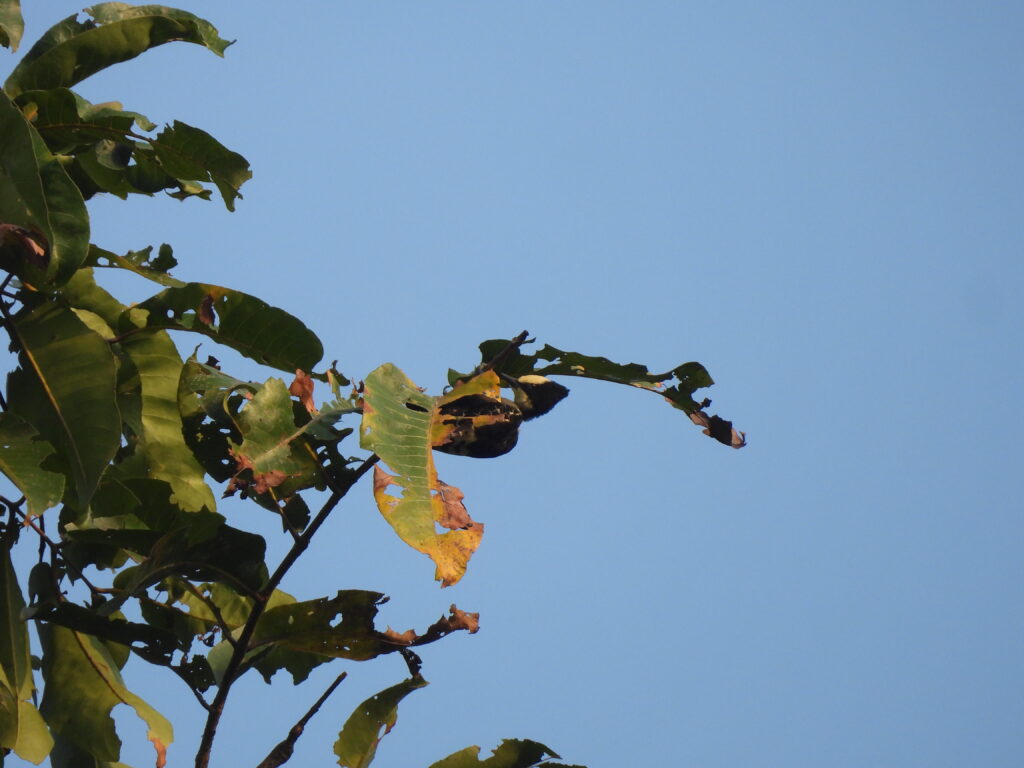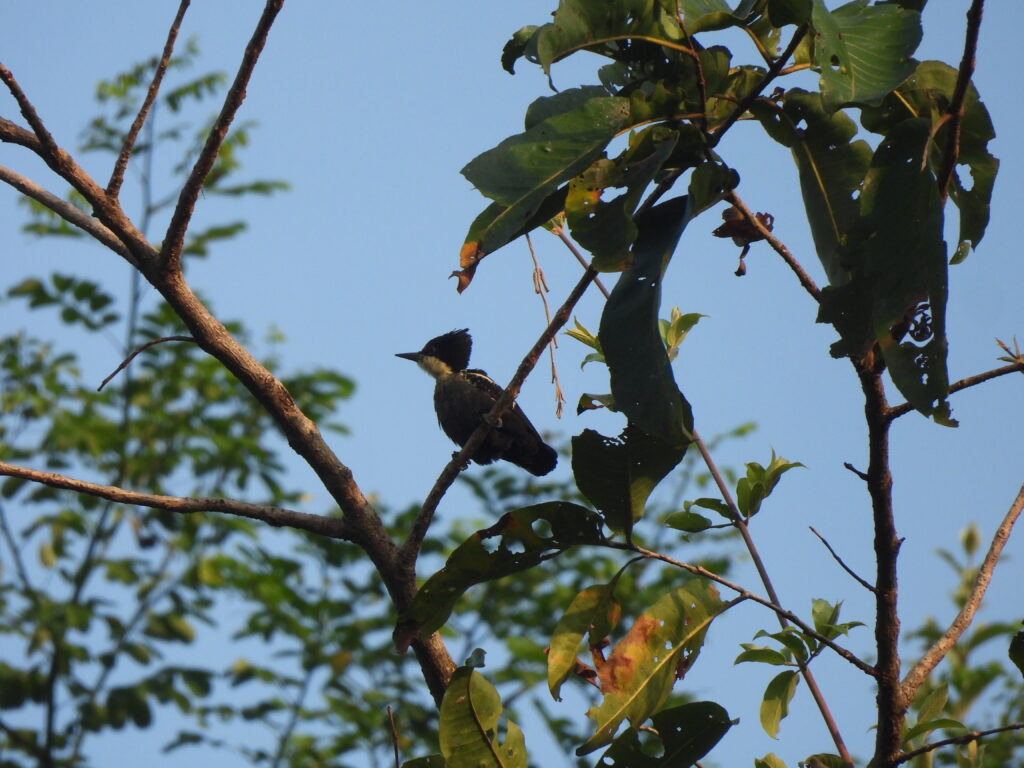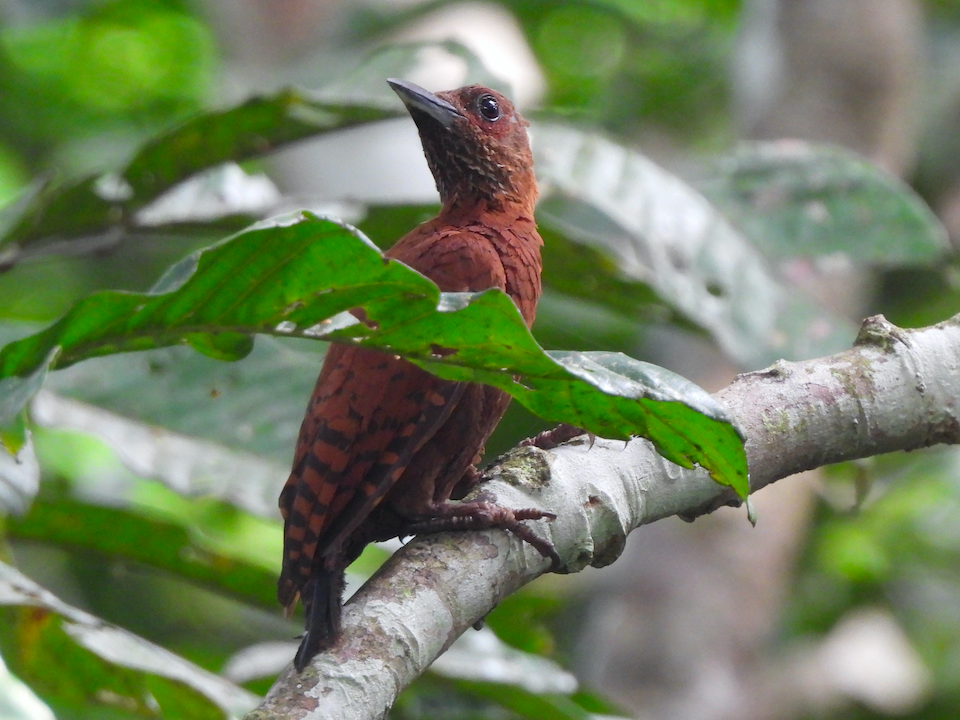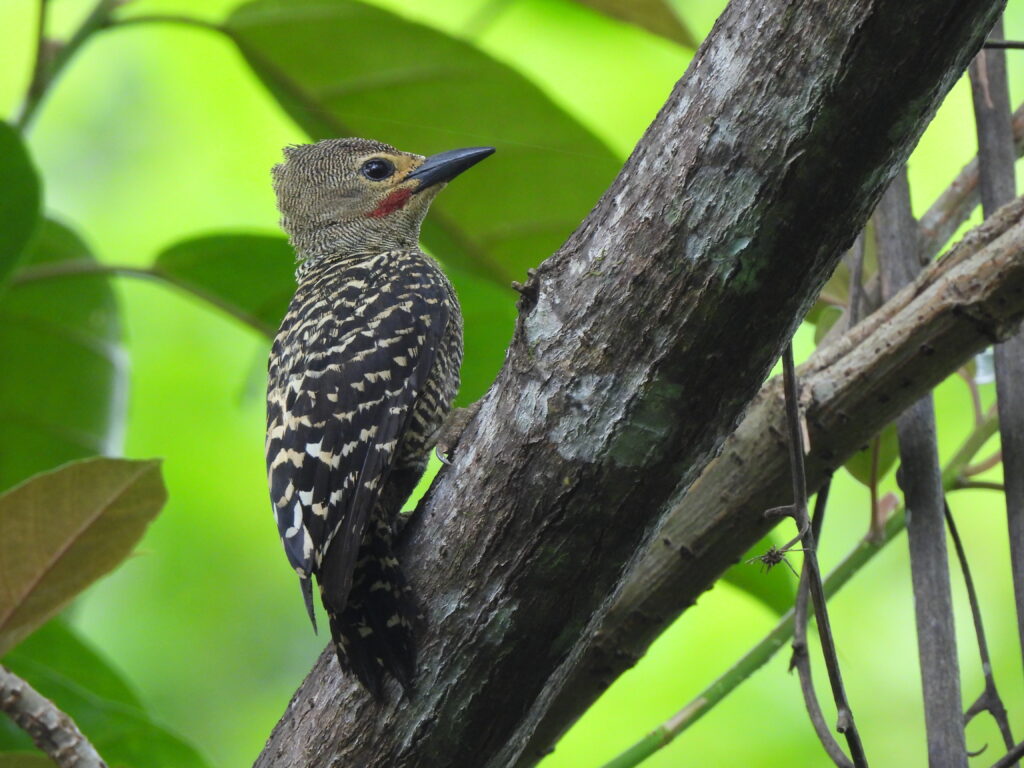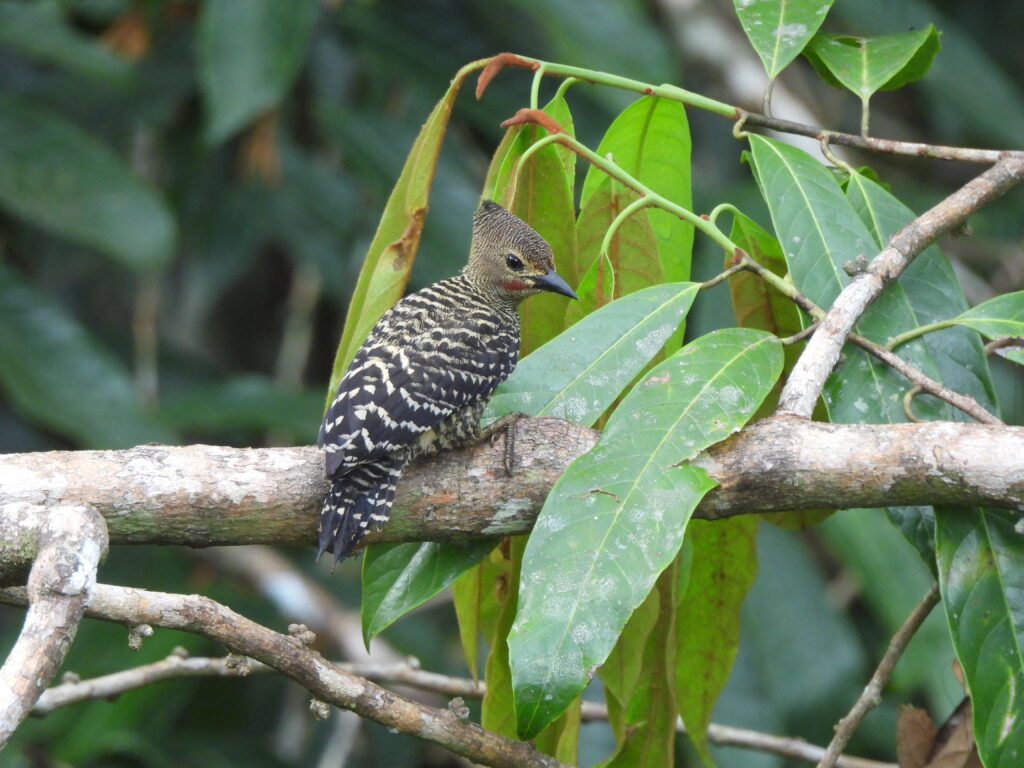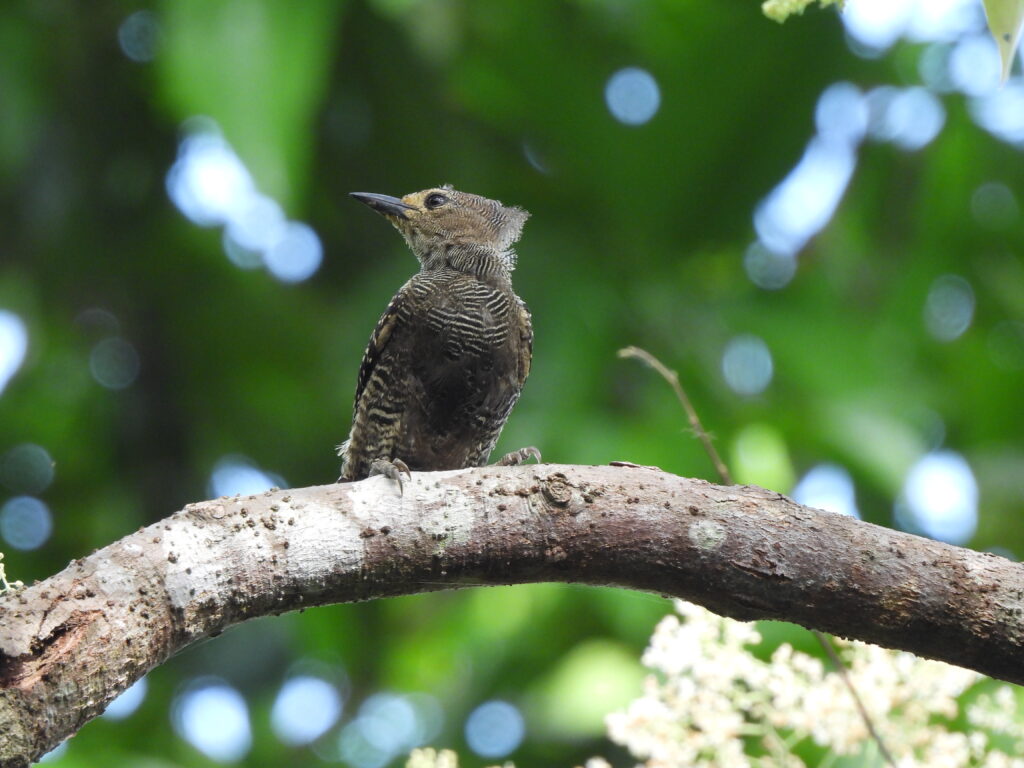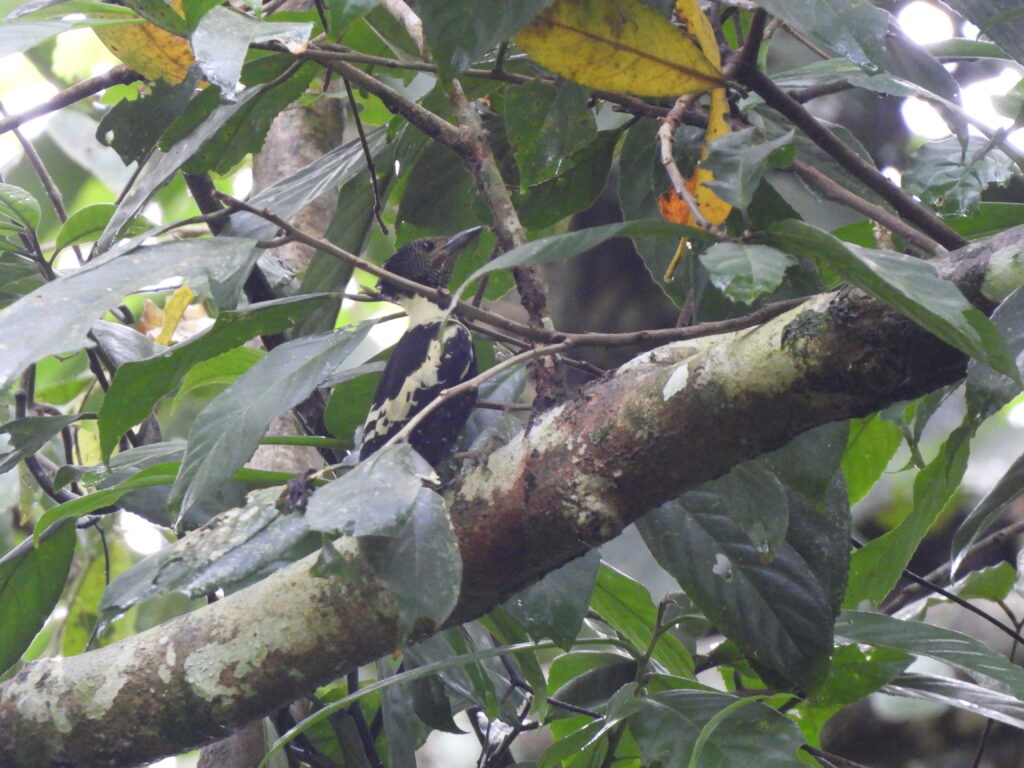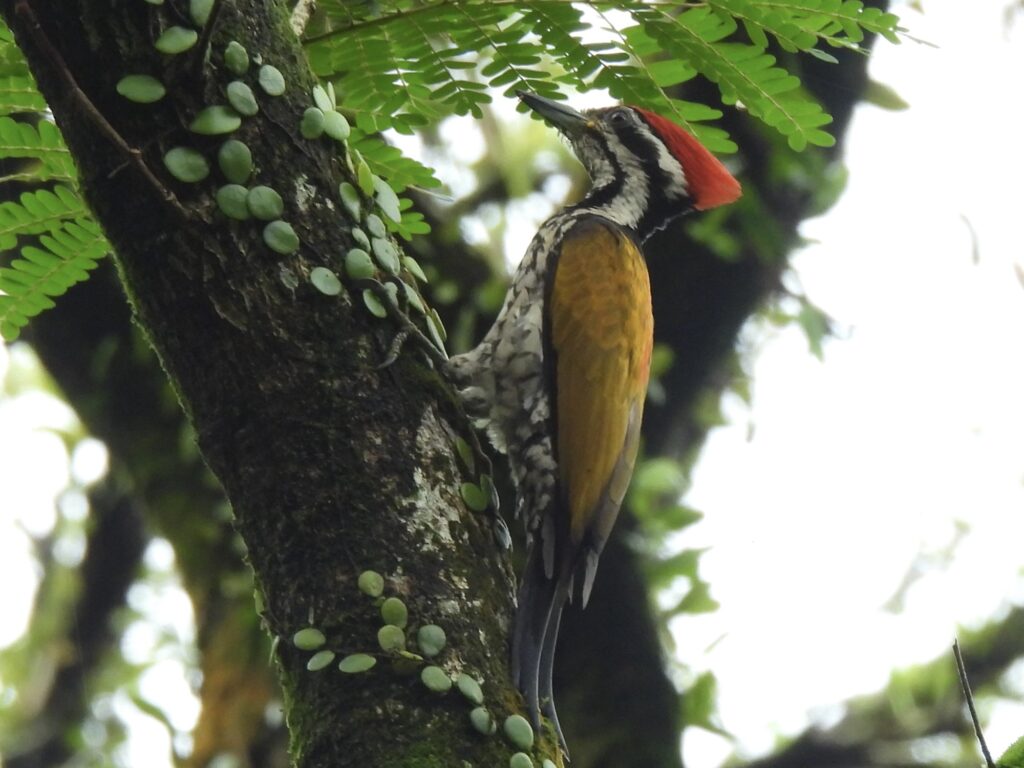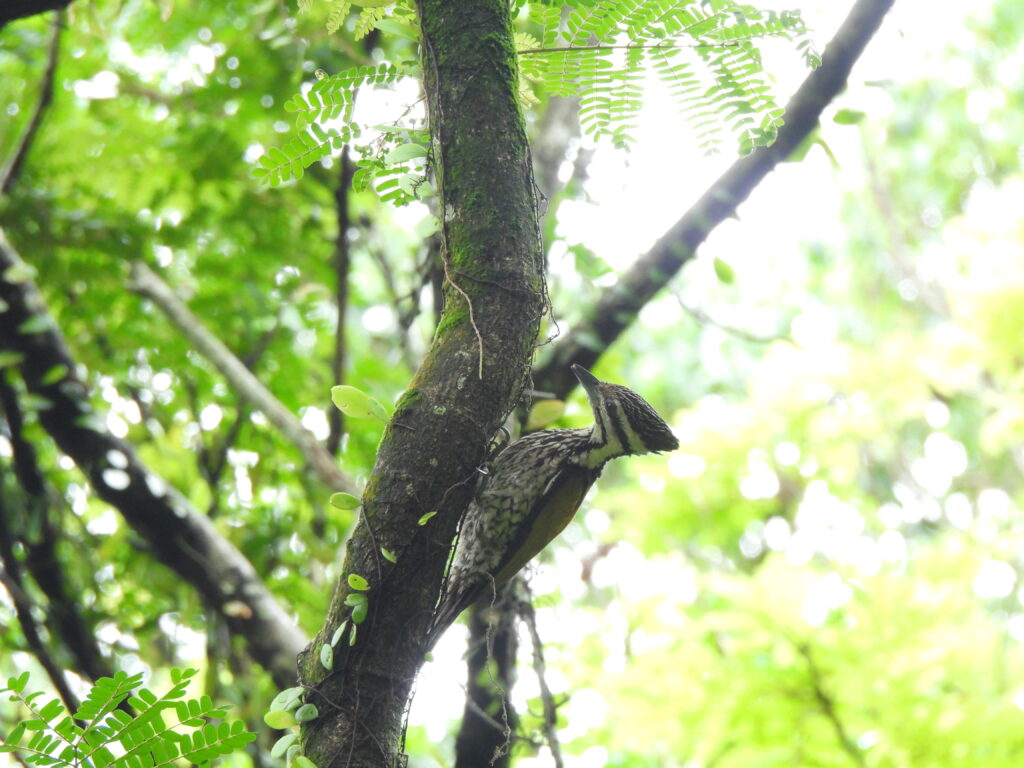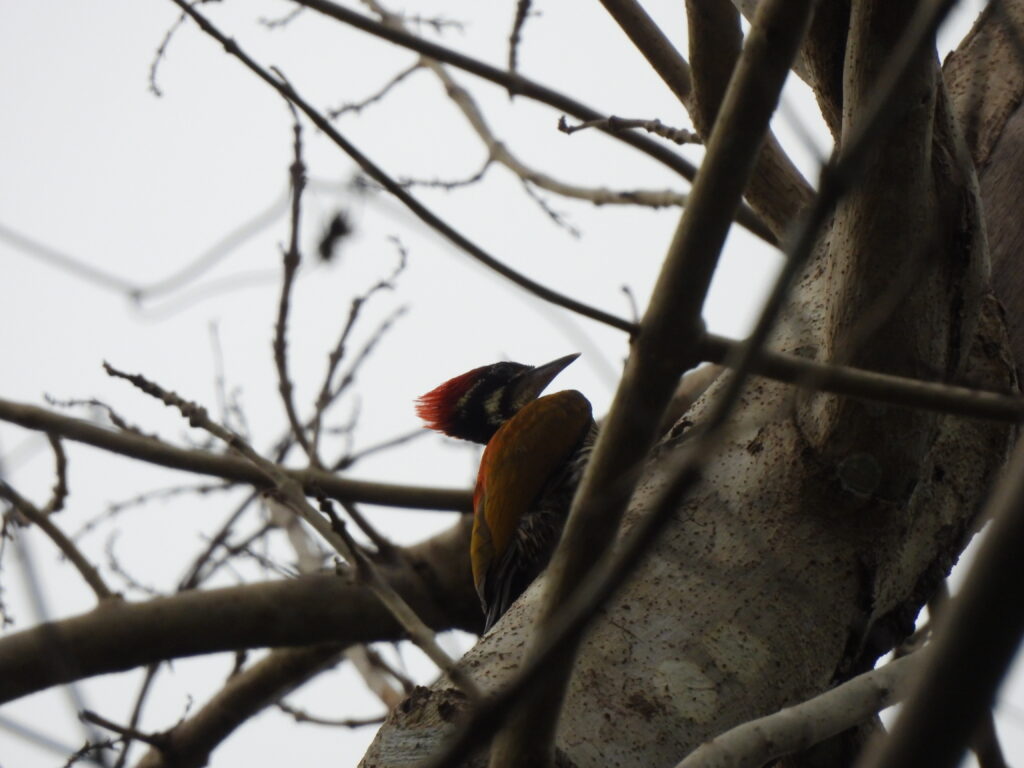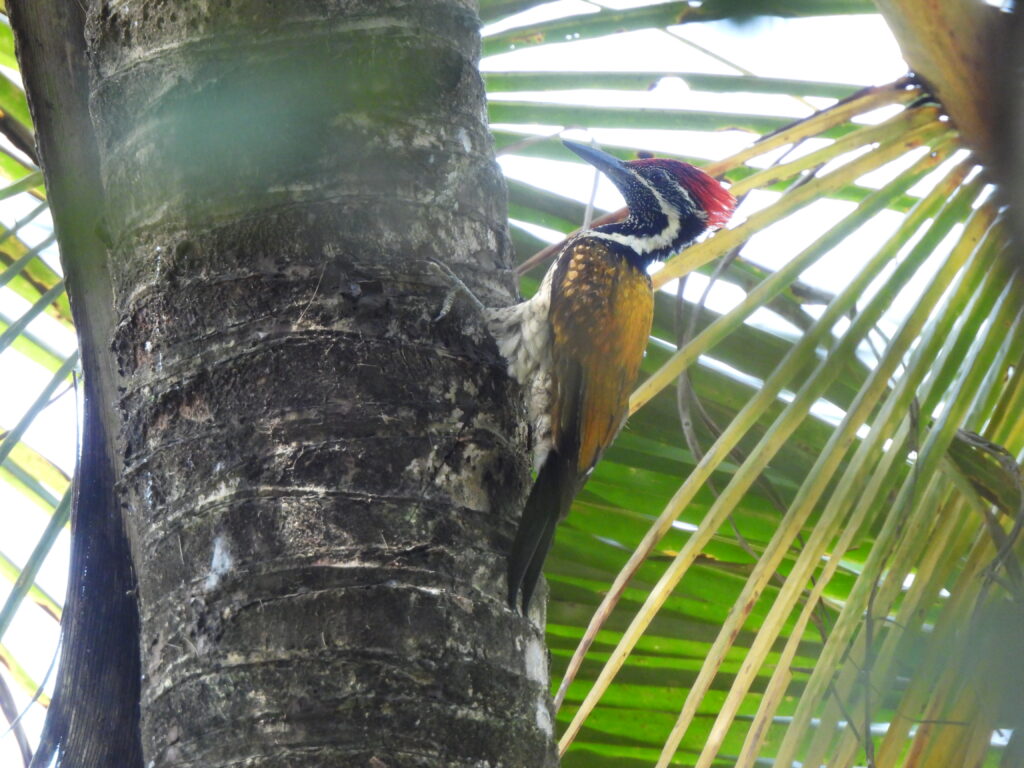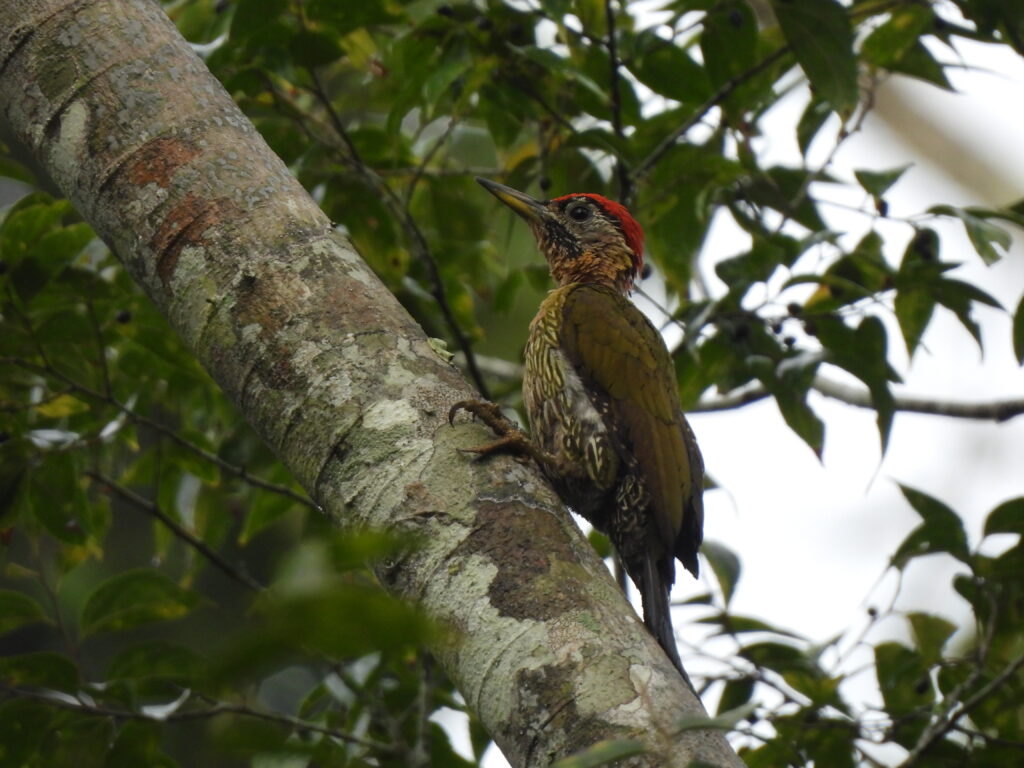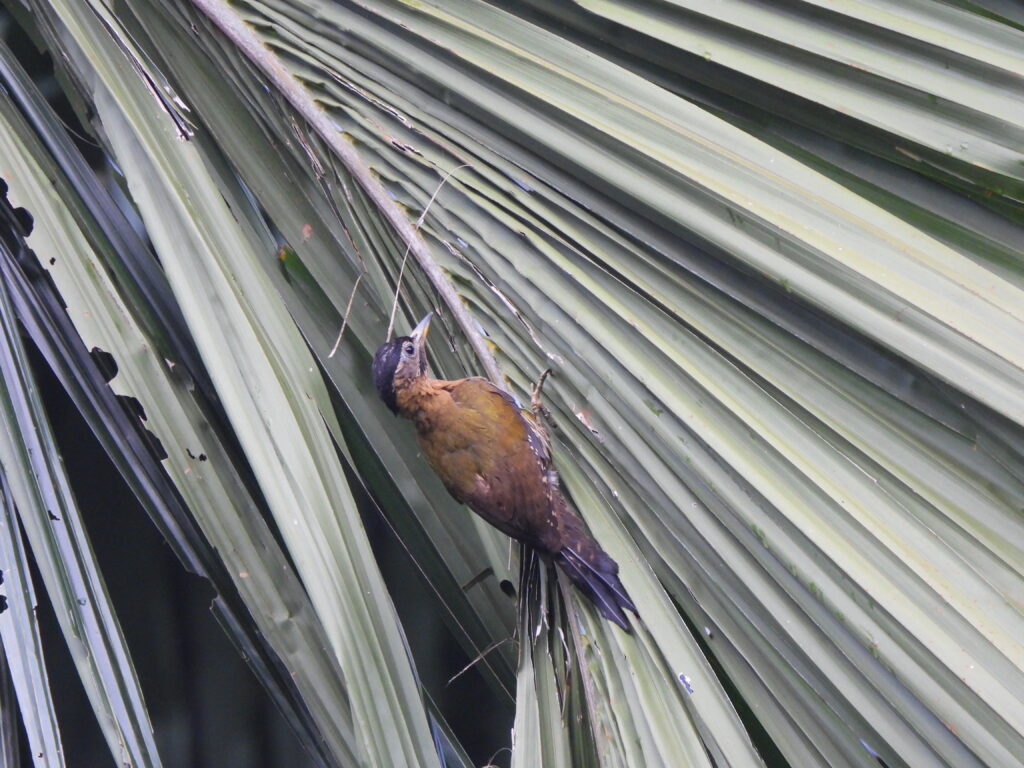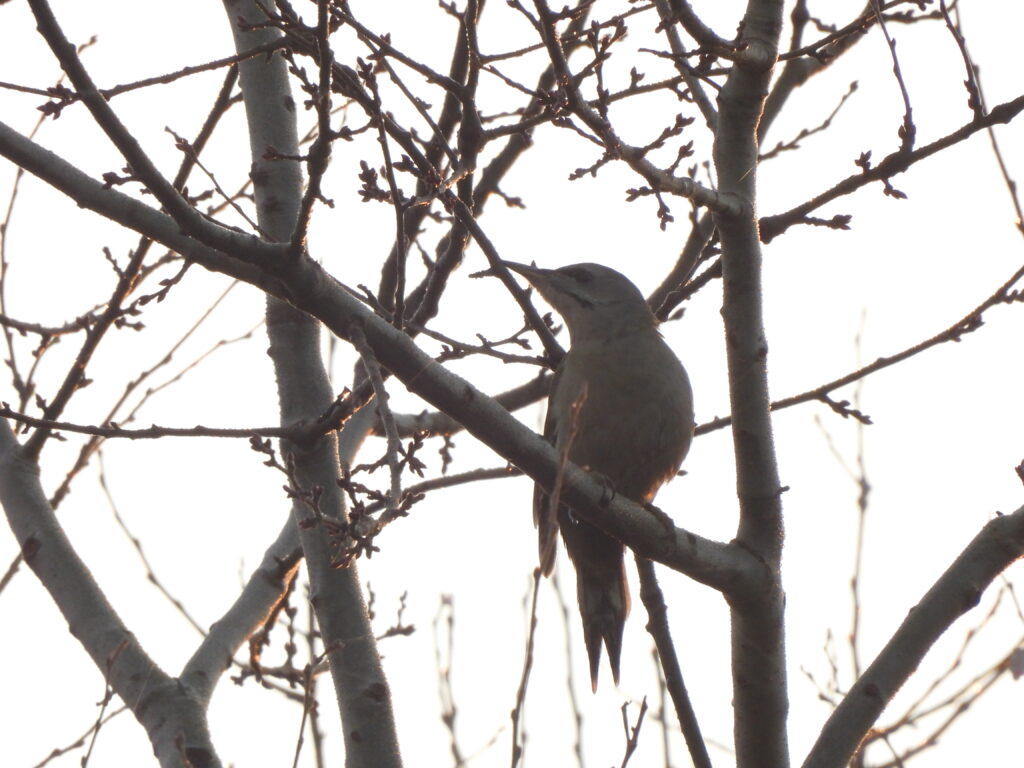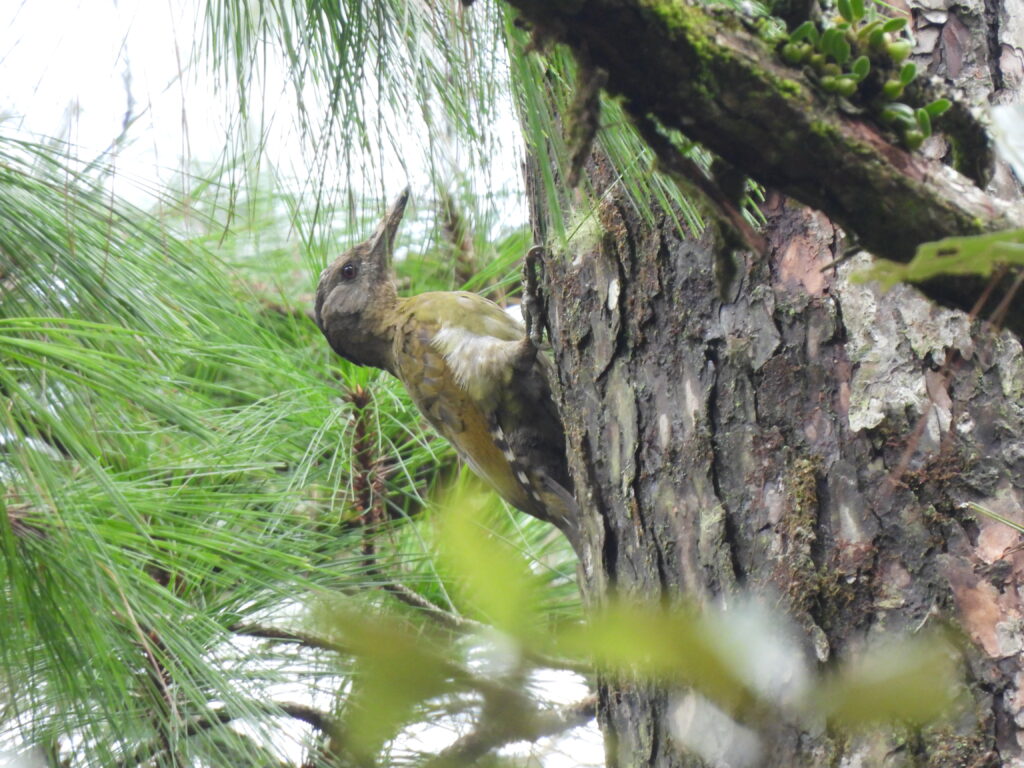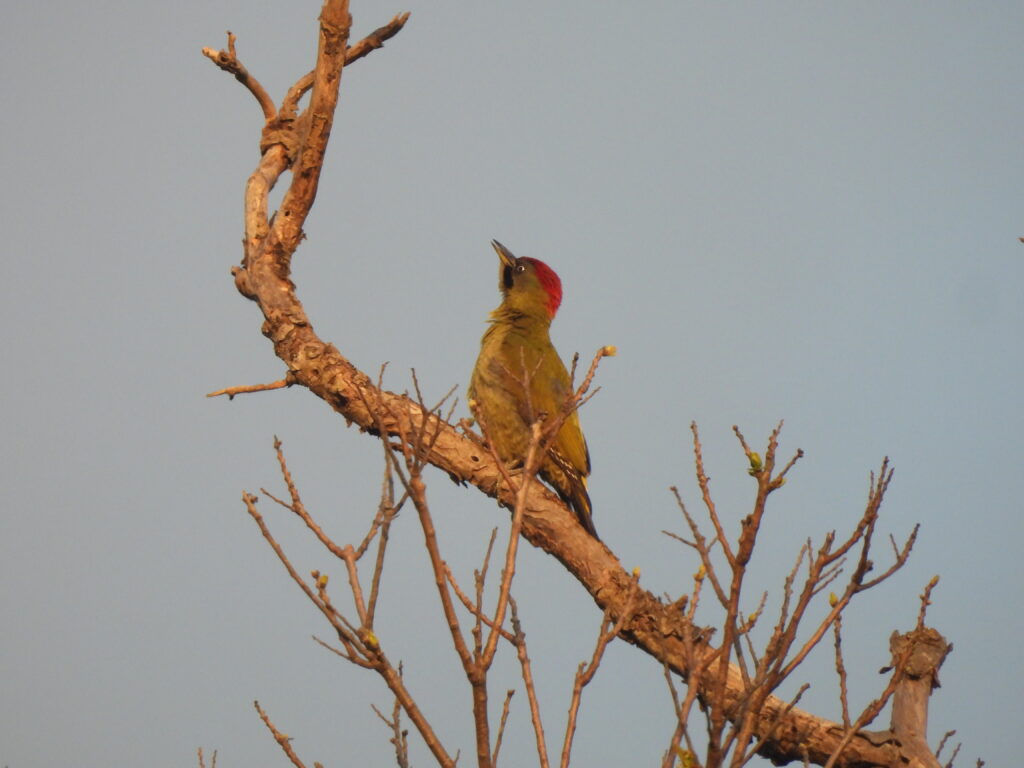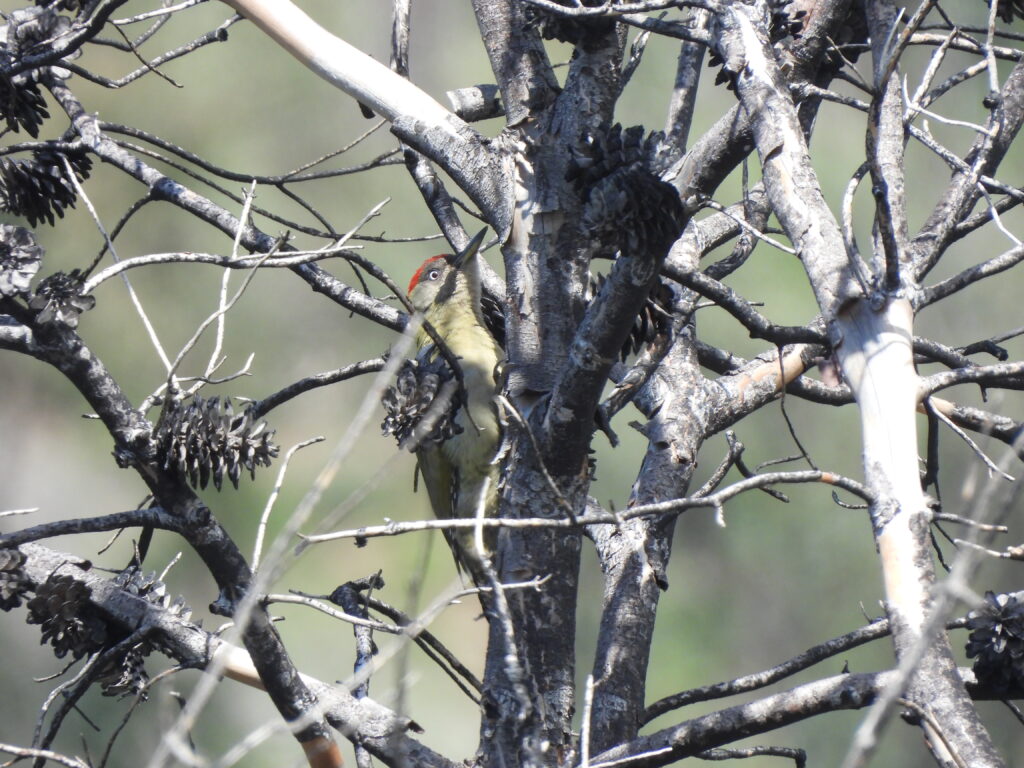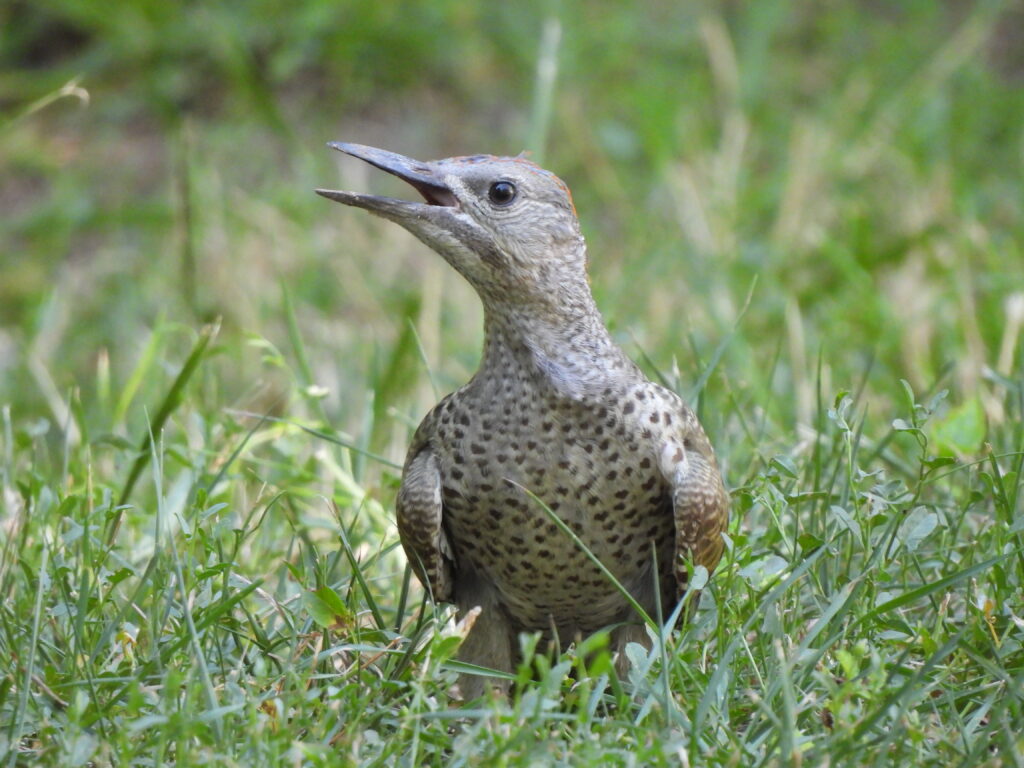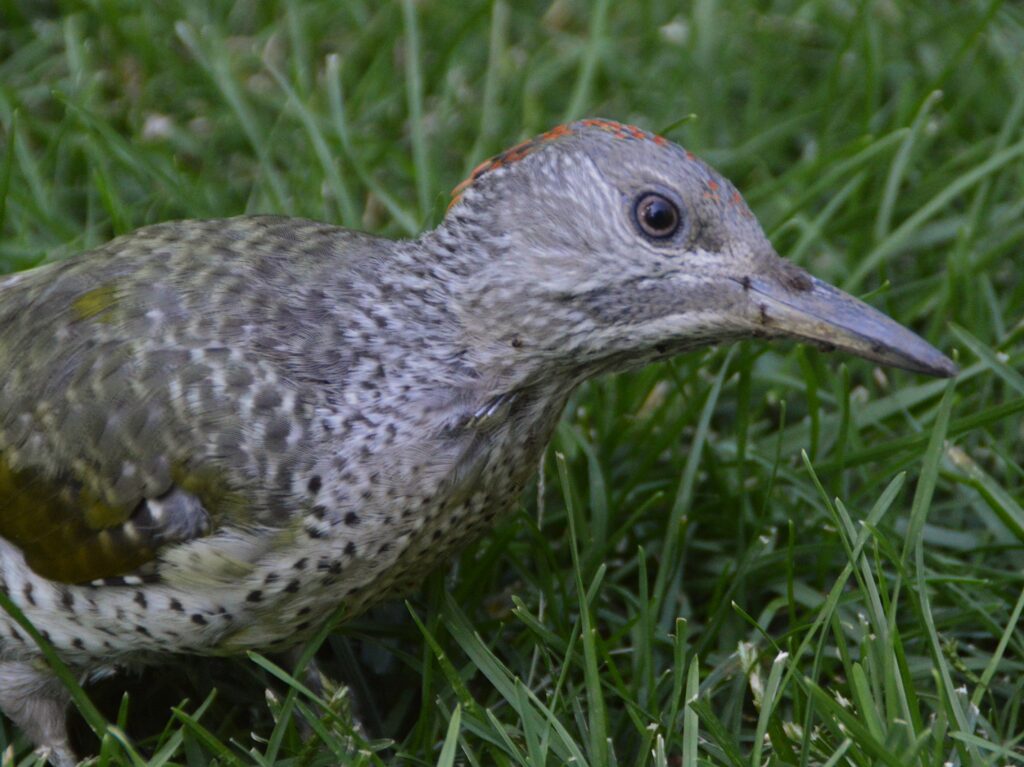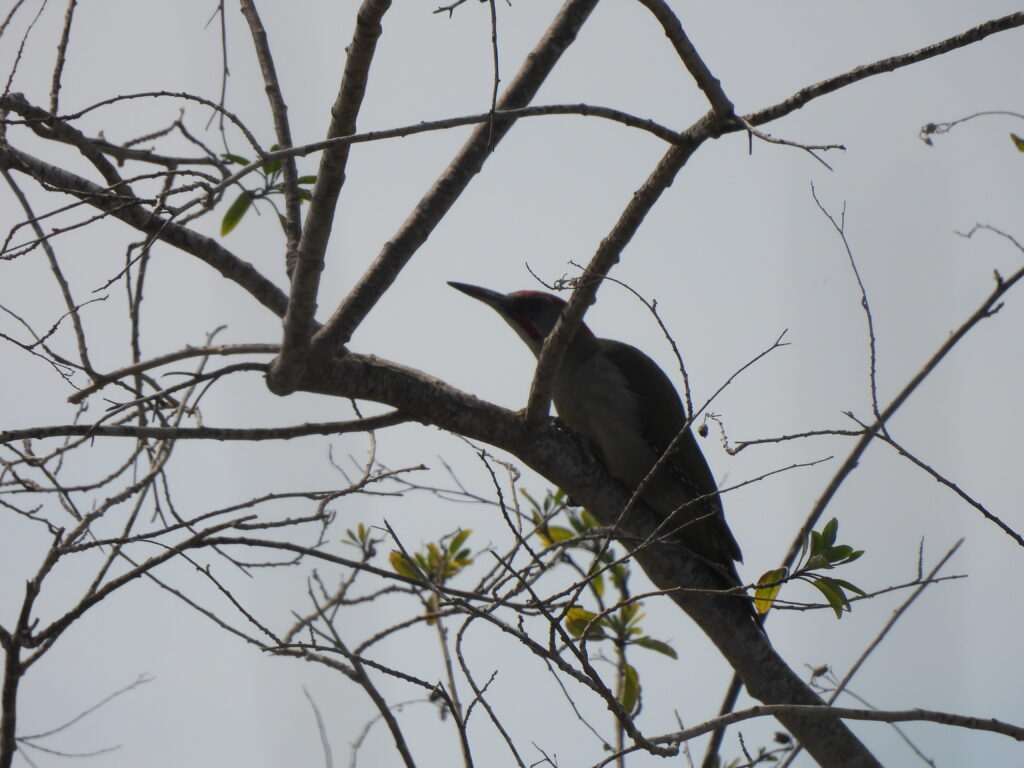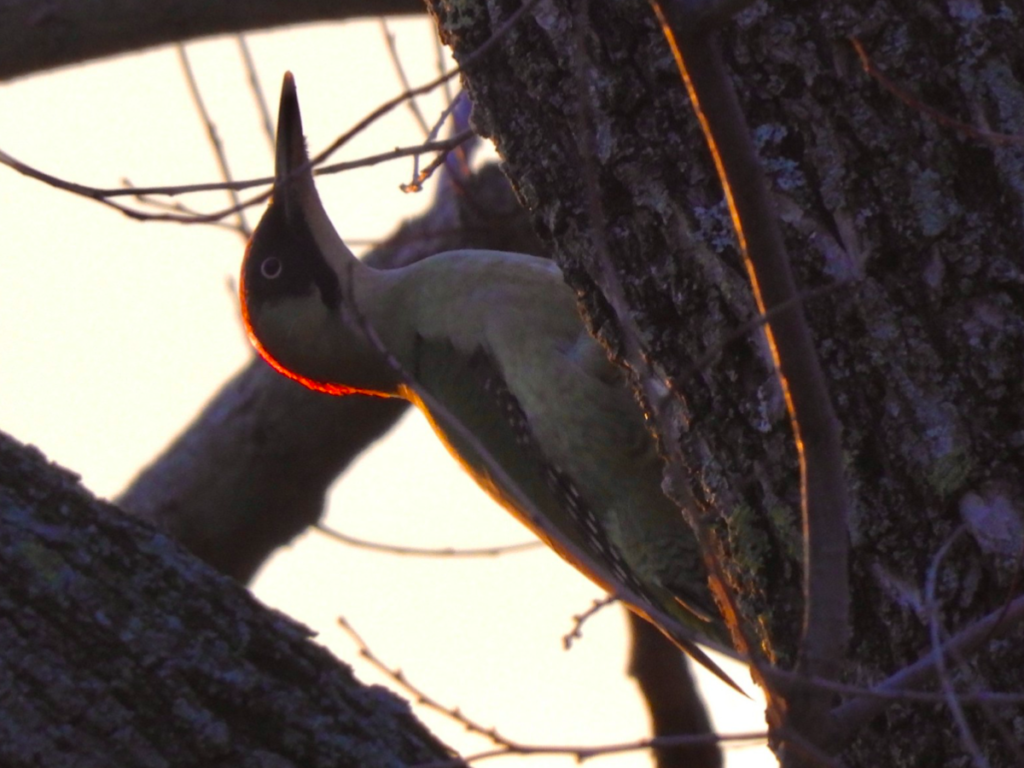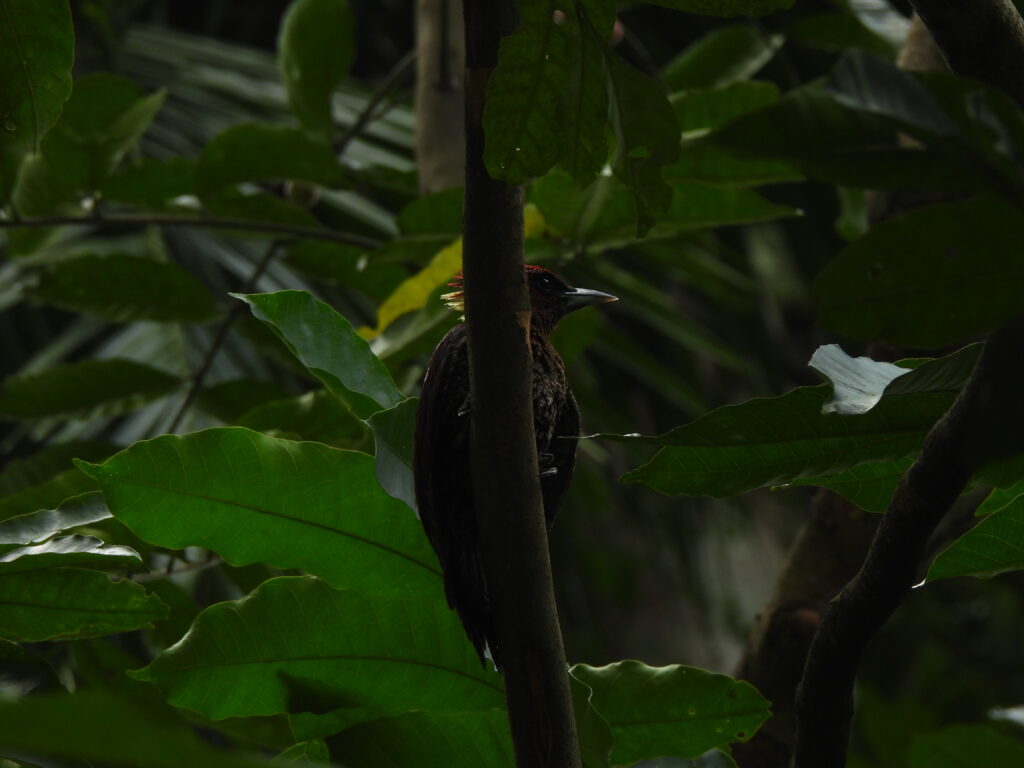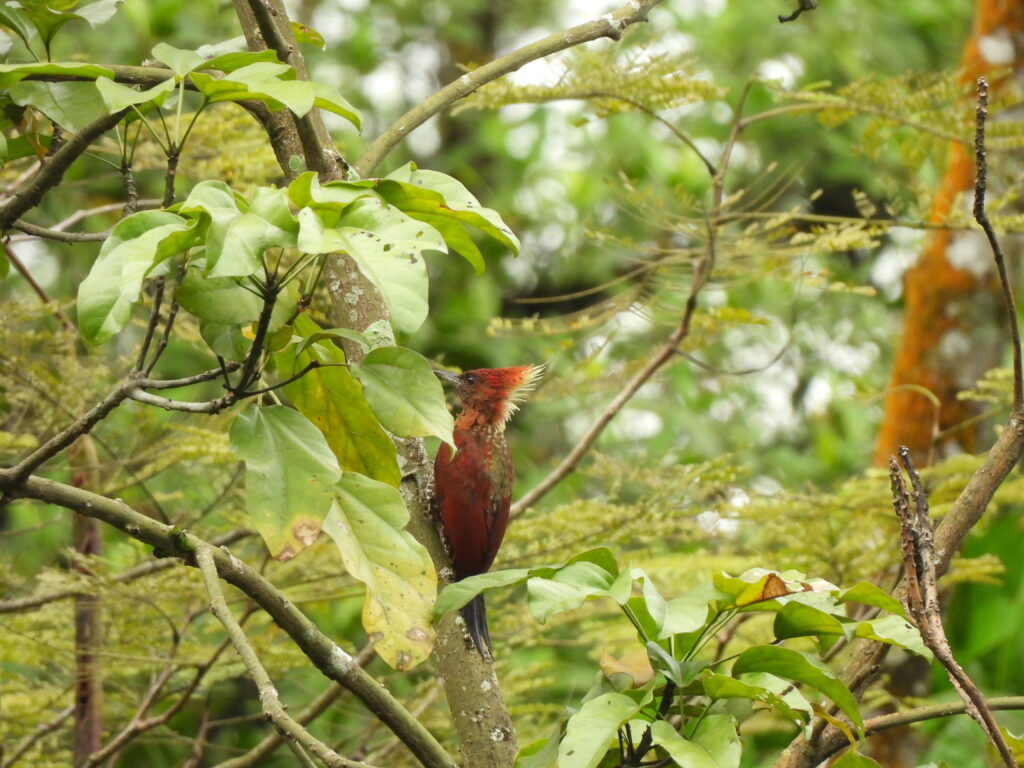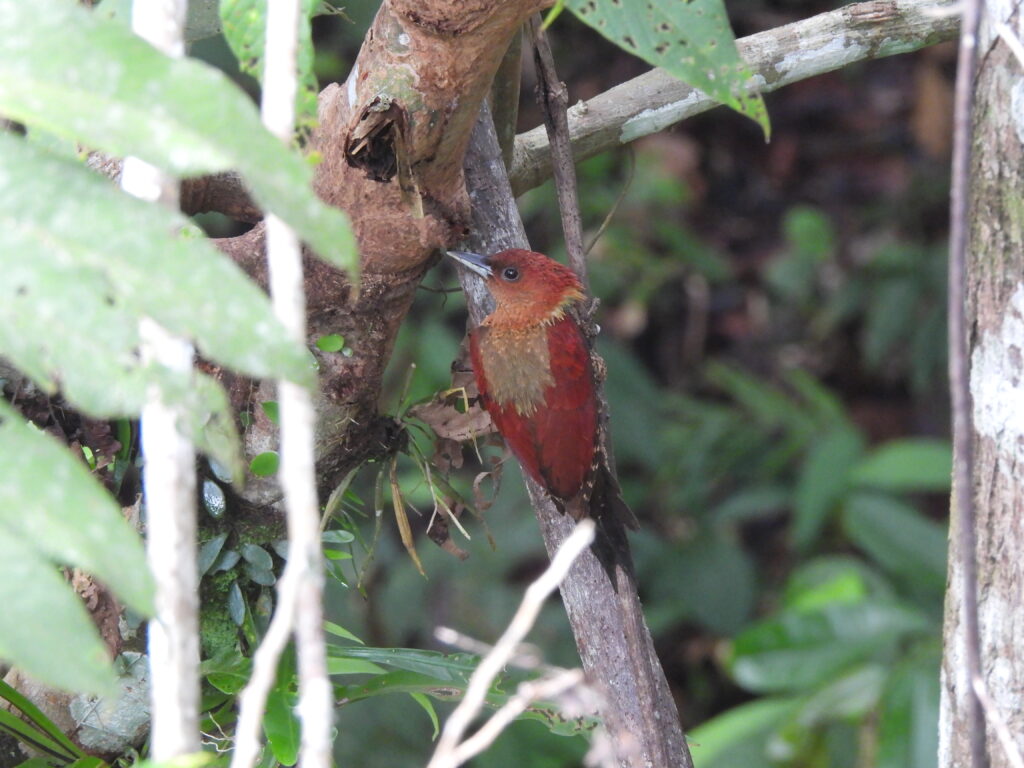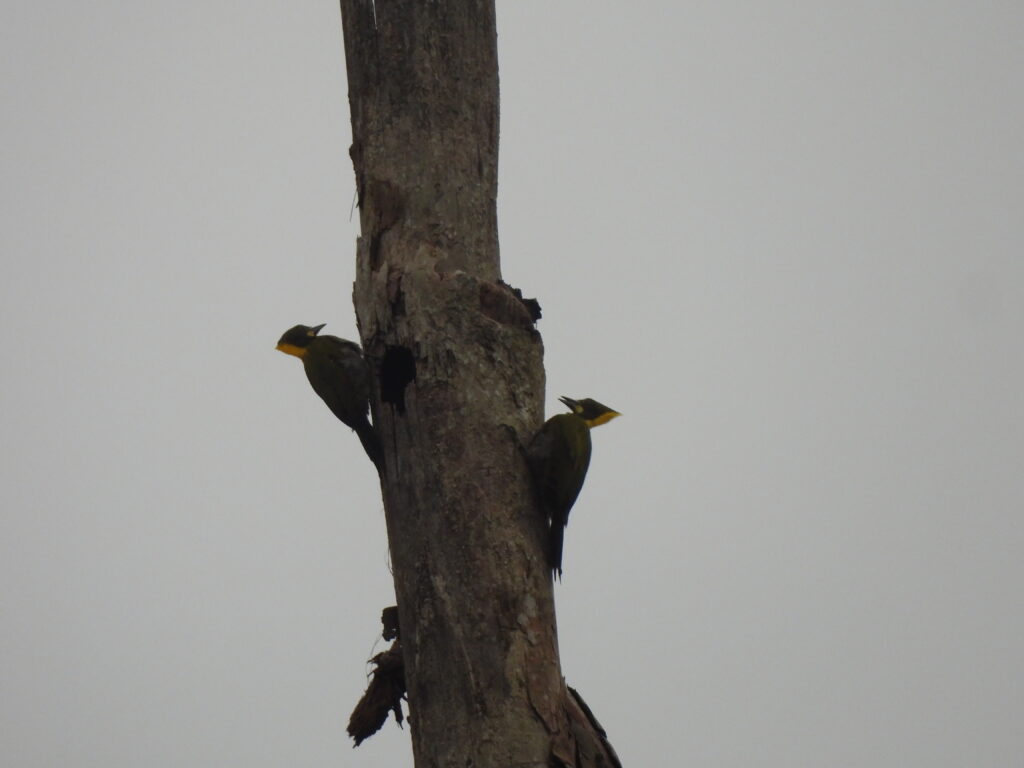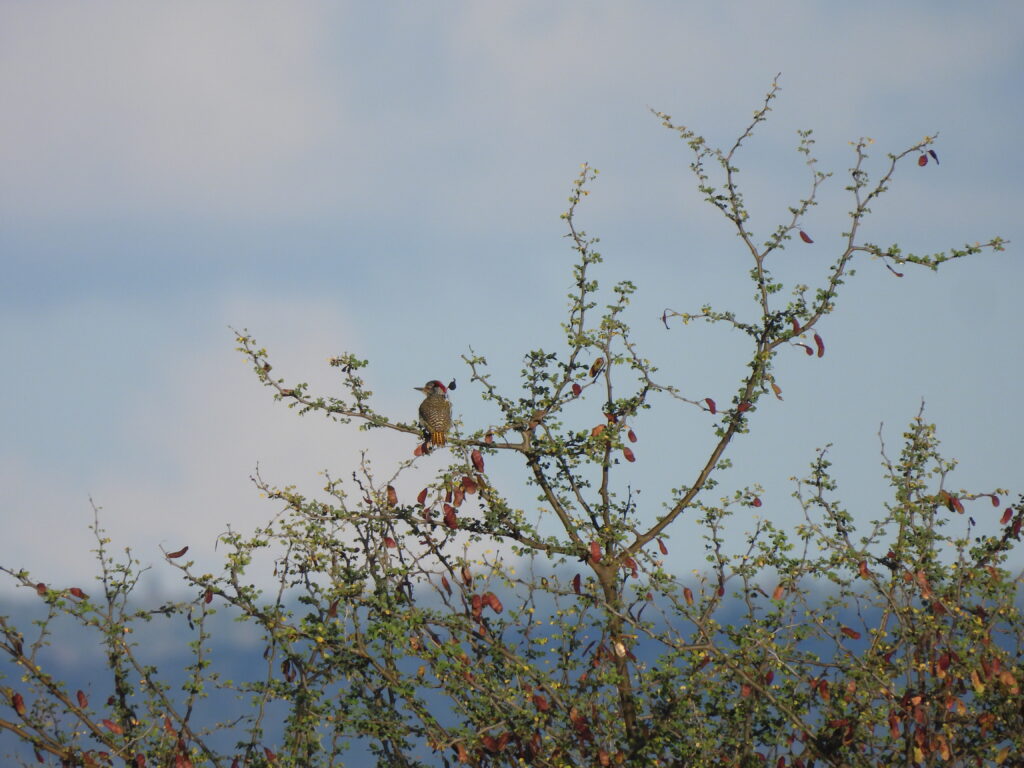The woodpeckers (family Picidae) are a family of birds belonging to the order Piciformes. They are found in forested areas (plus some terrestrial species in deserts and rocky habitats) worldwide, only being notoriously absent from Madagascar, Oceania and Antarctica. Woodpeckers are mostly acknowledged for their adaptation to capturing preys and carving holes in trees, with physical features that protect their brain when drumming. Indeed, drumming, along with generally loud laugh-like calls, are used for signaling and communication and can be used as ID features. Most species are solitary but some forage in pairs or engage in mixed-species foraging flocks. While sexes are generally similar, males of numerous species show red markings on the head that are absent on females — in some taxa, these heads have a notorious crest. A large, powerful bill, four-toed zygodactyl feet in most species and a stiff tail enhancing an upright posture while creeping trees are general features of most members of this family.
The family comprises 236 species in 36 genera. Basal genus Jynx (2 species) forms the unique subfamily Jynginae that includes the Old World wrynecks. Genera Picumnus (23 species), Verreauxia (1 species), Sasia (2 species) and Nesoctites (1 species) are generally known as piculets and conform the subfamily Picumninae.
All other woodpeckers belong to the subfamily Picinae. This first page aims to includes pictures of genera Hemicircus (2 species), Micropternus (1 species), Meiglyptes (4 species), Gecinulus (3 species), Dinopium (5 species), Picus (13 species), Chrysophlegma (3 species), Pardipicus (2 species), Geocolaptes (1 species), Campethera (10 species) and Mulleripicus (4 species).
The second page aims to include photos of genera Dryocopus (6 species), Celeus (12 species), Piculus (7 species), Colaptes (14 species of which 1 extinct), Campephilus (12 species of which 2 probably extinct), Blythipicus (2 species), Chrysocolaptes (10 species), Sphyrapicus (4 species), Xiphidiopicus (1 species), Melanerpes (23 species), Picoides (3 species), Yungipicus (7 species), Leiopicus (1 species), Dendrocoptes (3 species), Chloropicus (3 species), Dendropicos (12 species), Dendrocopos (12 species), Dryobates (6 species), Leuconotopicus (6 species) and Venilliornis (14 species).
Eurasian wryneck
Jynx torquilla
Odd, mostly migratory woodpecker which breeds in cavities on croplands and open woodlands across the Palearctic, from the Iberian Peninsula to Japan, and winters south in Africa, the Indian Subcontinent and Southeast Asia. Its name comes from a particular behavior displayed when disturbed at nest site, as birds would twist their necks and hiss like a snake. Small and inconspicuous. This species is an uncommon breeder and increasingly stays year-round in Alicante.
Speckled piculet
Picumnus innominatus
Diminutive woodpecker found in lowland and foothill forests with developed bamboo understory in Southeast Asia, southern China and locally in the Indian Subcontinent, Borneo and Sumatra. Drums loud despite its size. Among its genus — the smallest woodpeckers —, it is the only species found outside the Neotropics. I have observed this species in Bukit Fraser in Malaysia.
Heart-spotted woodpecker
Hemicircus canente
Local in dense, generally wet lowland and foothill forests of southern India and Southeast Asia. Small and black-and-white, named after the dark heart-shaped feathers on the otherwise white shoulders when perched. Females show a white frontal patch, which is black in males. I have seen this species in Vietnam and India.
Rufous woodpecker
Micropternus brachyurus
Well spread in many tropical moist forest types from the Western Ghats, the Himalayas and Sri Lanka through Southeast Asia to Borneo, Java or China’s Fujian region. Brownish overall and medium-sized, it often joins mixed-species foraging flocks. I have seen this species in Borneo and India.
Buff-rumped woodpecker
Meiglyptes grammithorax
Small woodpecker of lowland and foothill forest and forest edge restricted to the Malay Peninsula, Borneo and Sumatra. Attractive, with a finely barred pattern covering all the body. Males have a red malar stripe whereas females lack a moustache. I have seen this species in Borneo.
Black-and-buff woodpecker
Meiglyptes jugularis
Uncommon woodpecker of clearings and edge of lowland and foothill moist forests locally in Southeast Asia. It shows bold white markings along nape and wings, and sports a large, distinctive black crest. Males show a very faint red marking on the base of the bill. I have observed this species in Thailand.
Common flameback
Dinopium javanense
Distinctive woodpecker of wet tropical forests of Southeast Asia and Sundaland, with an isolated, small population in the Western Ghats. Males have a bright red crest, which is black in females. It is a member of the so-called ‘small-billed’ flamebacks, only distantly related to the large-billed flamebacks. I have seen this species in Peninsular Malaysia, Borneo, Vietnam and Thailand.
Spot-throated flameback
Dinopium everetti
Endemic to Palawan and neighboring islands, where it occurs in lowland forests and plantations. It often joins mixed-species foraging flocks, sometimes foraging with the larger woodpeckers of the island. It is generally more rufous than other relatives, and males have a distinctive bright red crest and nape, which are black in females. I saw this species on a trip to the Philippines.
Black-rumped flameback
Dinopium benghalense
Endemic to the Indian Subcontinent, where it is abundant in most wooded habitats, including cultivated and urbanized areas and excluding dense, pristine rainforests. Unlike other members of its genus, this species shows a black throat and four instead of three toes. Females have only the back half of their crest bright red. I have observed this species in India.
Laced woodpecker
Picus vittatus
Found in lowland and foothill moist forests of Southeast Asia, Malay Peninsula, Sumatra and Java. Medium-sized, beautiful typical green woodpecker with a black malar stripe and with a crown which is red in males and black in females. I have seen this species in Singapore, Vietnam and Thailand.
Gray-headed woodpecker
Picus canus
Widespread across the Palearctic, from mixed forests of France or Norway in Europe to Hokkaido and Russian Far East, all the way to the montane forests of the Himalayas and the moist tropical forests of Southeast Asia and Sumatra. There are big morphological variations across its range, with several forms proposed as species in the past. The nominate canus form is quite uncommon in Helsinki. I have seen the ‘black-naped‘ guerini form in Vietnam.
Levaillant’s woodpecker
Picus vaillantii
Endemic to montane forests of Maghreb in the North Atlas, from Morocco to Tunisia. Recently splitted from the European green woodpecker, but lacks black lores and shows light yellowish eyes, and both sexes have dark malar stripes — females of this species only have red in the back half of the crown. I have seen this species in Ceuta, a Spanish exclave in North Africa where a narrow population has recently established.
Iberian green woodpecker
Picus sharpei
Endemic to the Iberian Peninsula and far south France, where it can be found in most wooded habitats. Recently splitted from the European green woodpecker, but has certain morphological differences such as lacking black lores. Generally shy, although used to people and found in gardens of certain large cities. This species is an abundant resident in wooded areas of Alicante.
European green woodpecker
Picus viridis
Common woodpecker of most wooded habitats of Central and Eastern Europe, Great Britain, southern Scandinavia and the Caucasus. Beautiful green woodpecker with a large red head stripe, white eyes and broad black lores creating a mask, with red malar stripes in males and black in females. I have seen this species in Greece.
Banded woodpecker
Chrysophlegma miniaceum
Found in lowland and foothill forests and gardens of the Malay Peninsula, Sumatra, Borneo and Java. Attractive maroon and reddish pattern with a finely barred belly and bright yellow spikes on crest. I have seen this species in Singapore, Peninsular Malaysia and Borneo.
Greater yellownape
Chrysophlegma flavinucha
Found mostly on montane forests of Southeast Asia to the Himalayas and Sumatra. Relatively large, overall green woodpecker with bright yellow whiskers and back of the crest. I have observed this species in Peninsular Malaysia and Vietnam.
Nubian woodpecker
Campethera nubica
Common woodpecker of savanna habitat of Eastern Africa from Sudan to Tanzania. Black-and-white speckled pattern overall its body, with yellowish and greenish hues in wings and tail. Only males have a full crown and malar stripe red. I have seen this species in Kenya.
Great slaty woodpecker
Mulleripicus pulverulentus
The largest woodpecker species globally, generally found in very low densities in pristine lowland forests of Southeast Asia from the Himalayas to Palawan, Borneo and Java, albeit not known from Sumatra. Massive and odd-looking, overall gray with a light orange throat. I have only briefly seen this species crossing Kinabatangan River in flight in Borneo.

